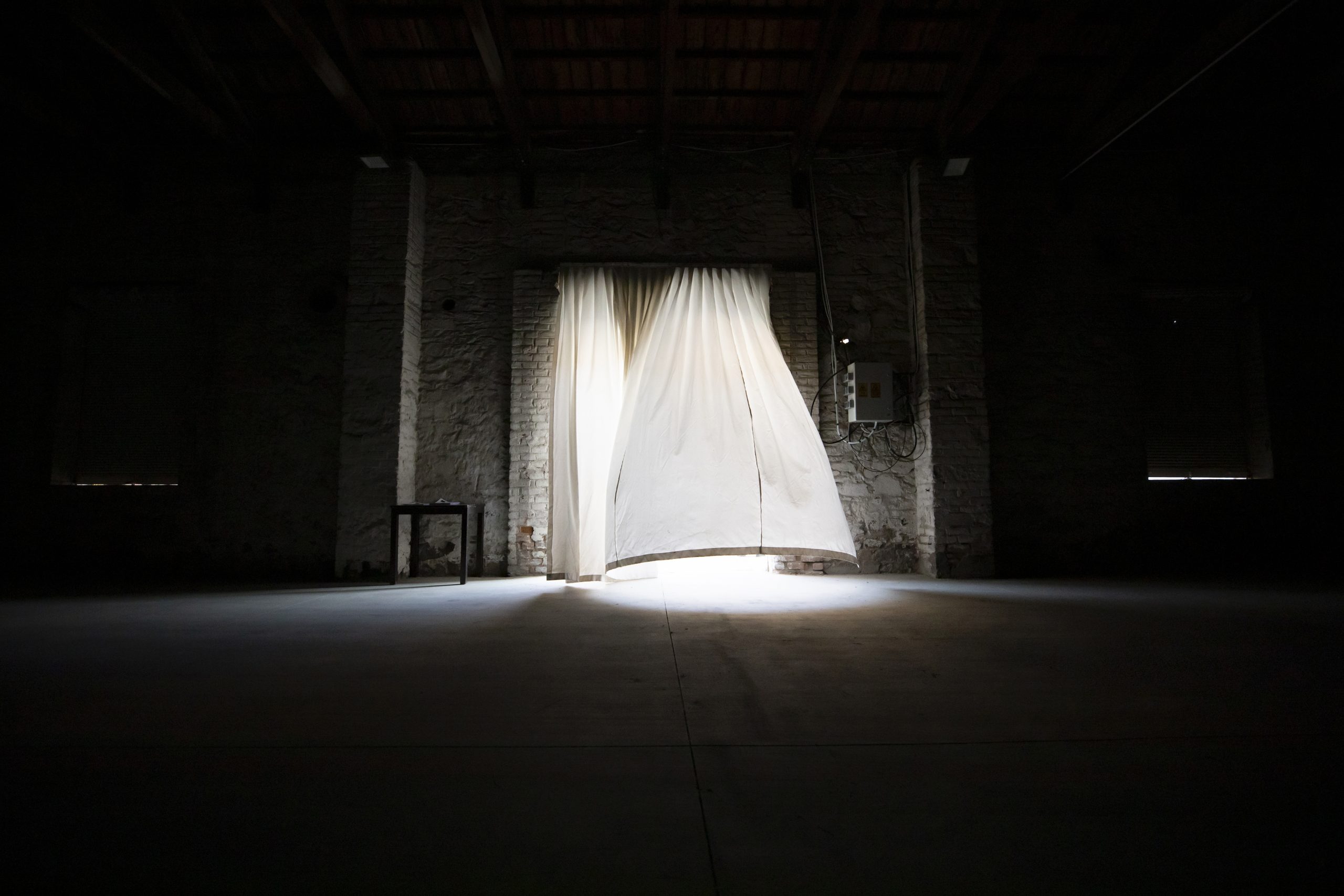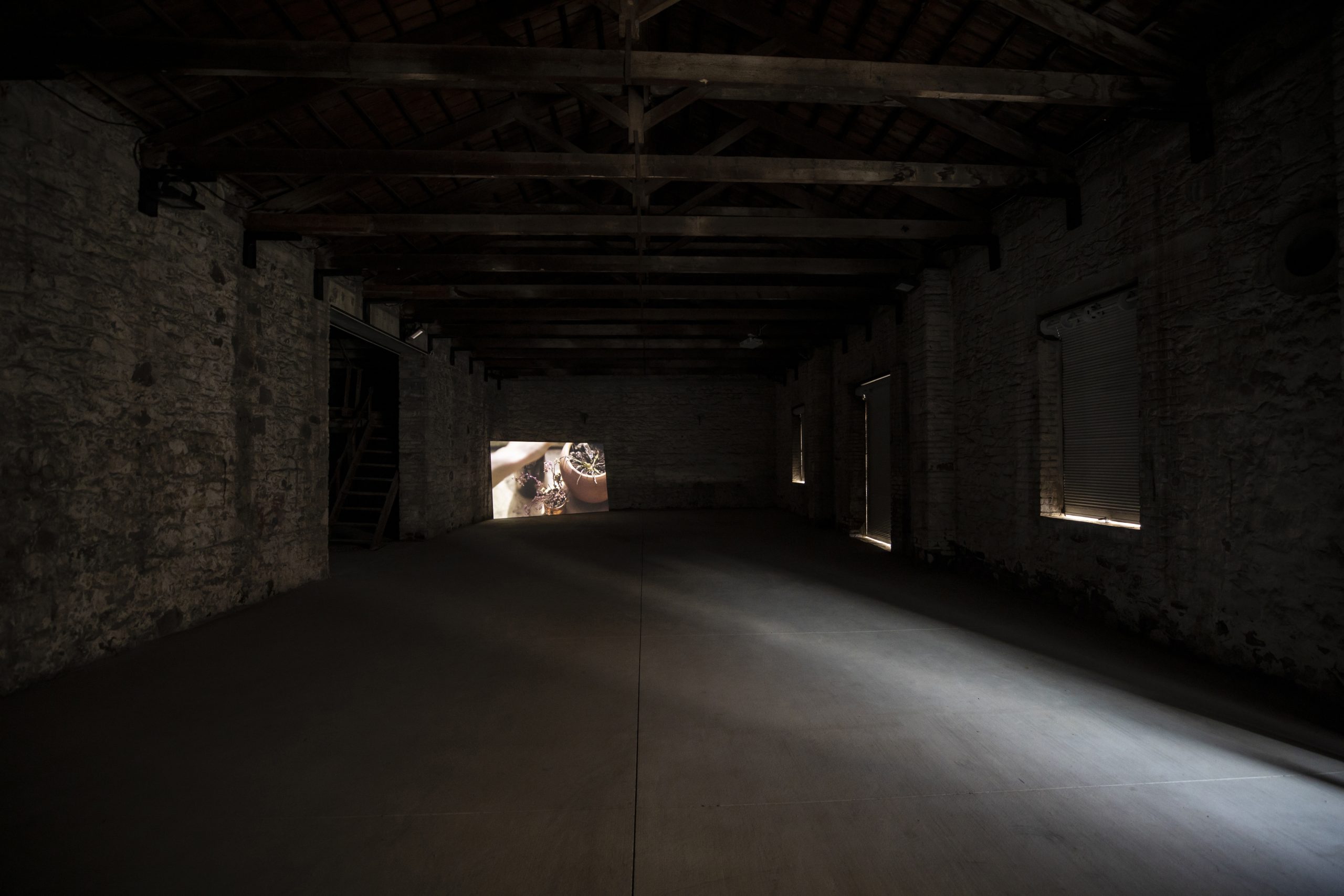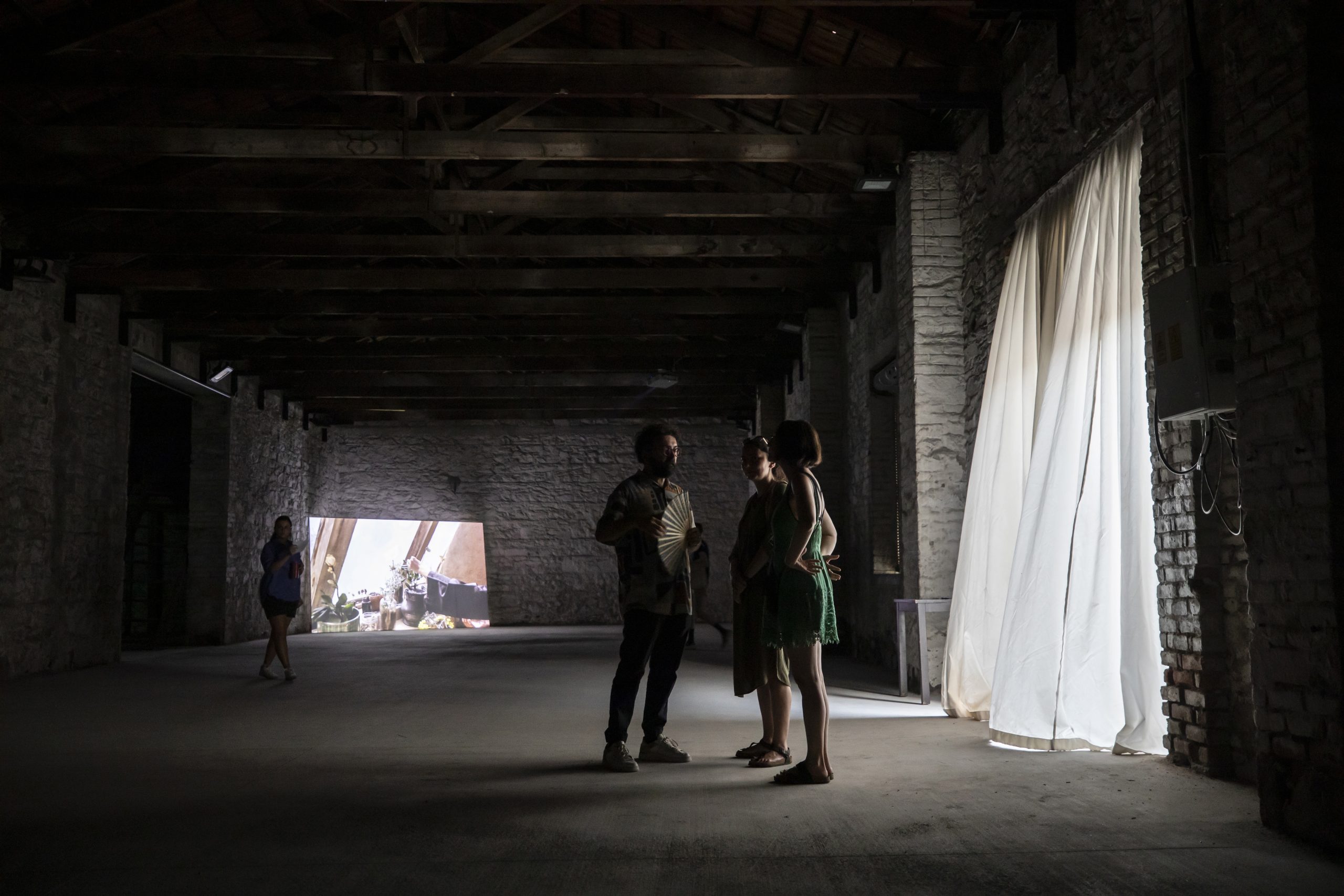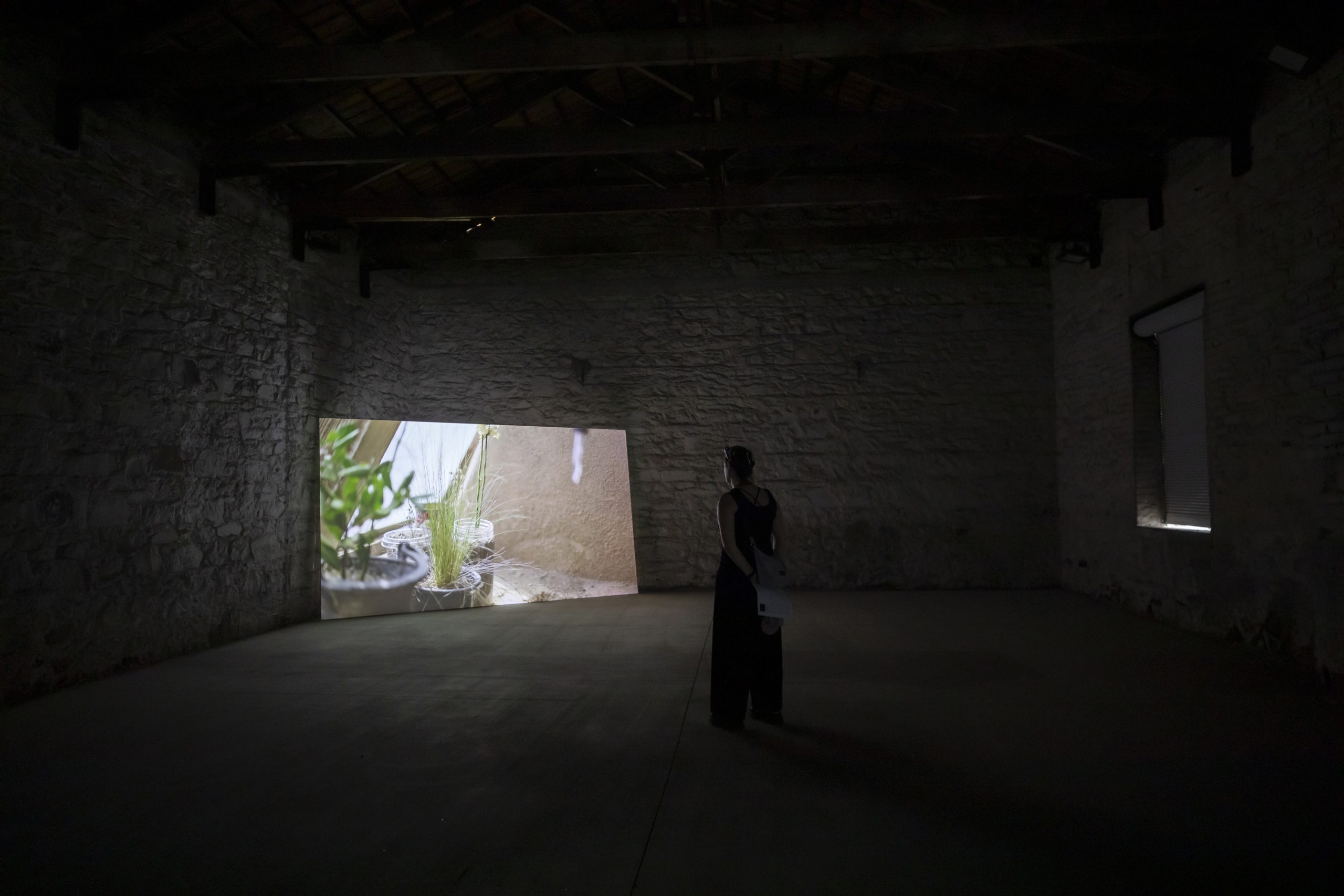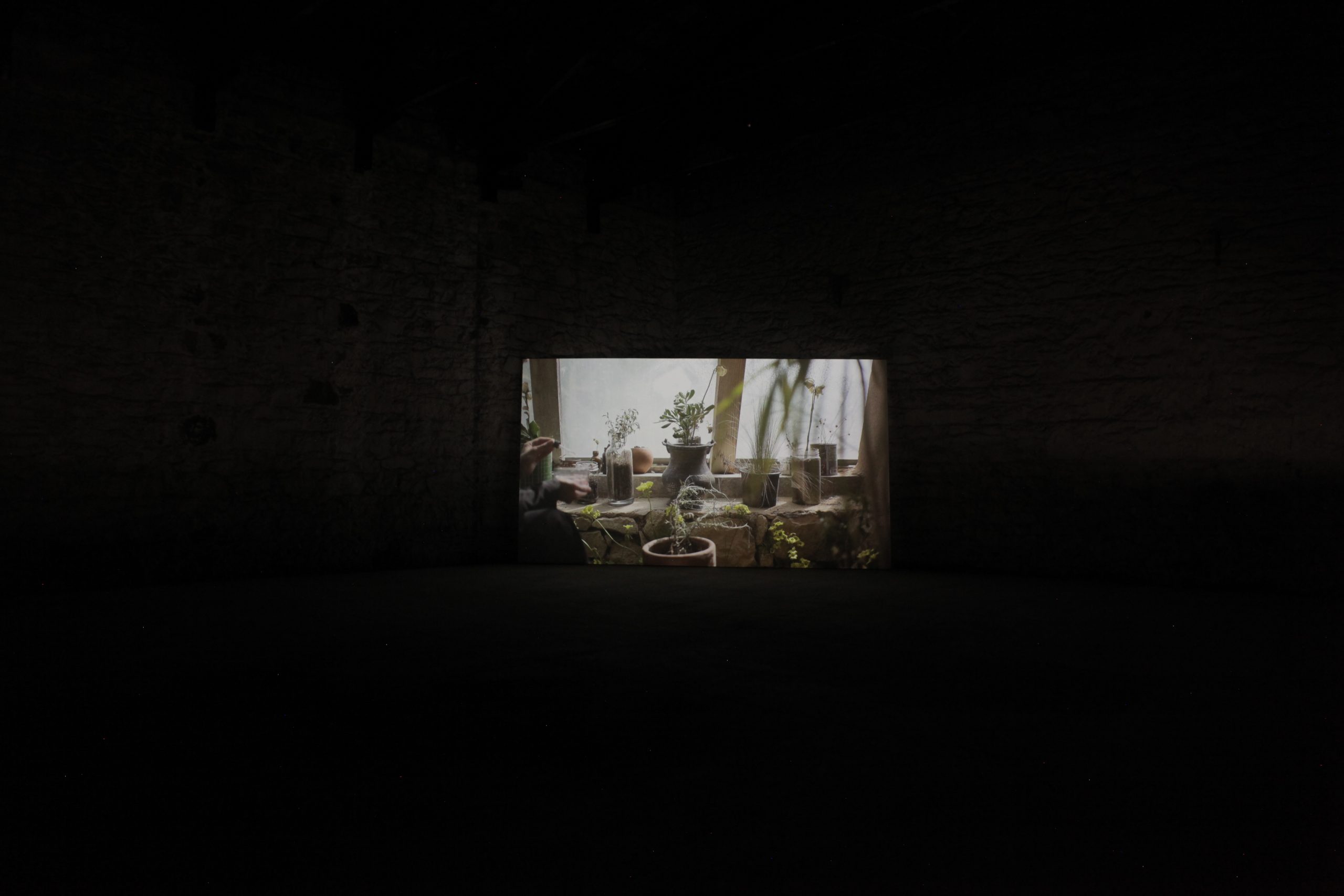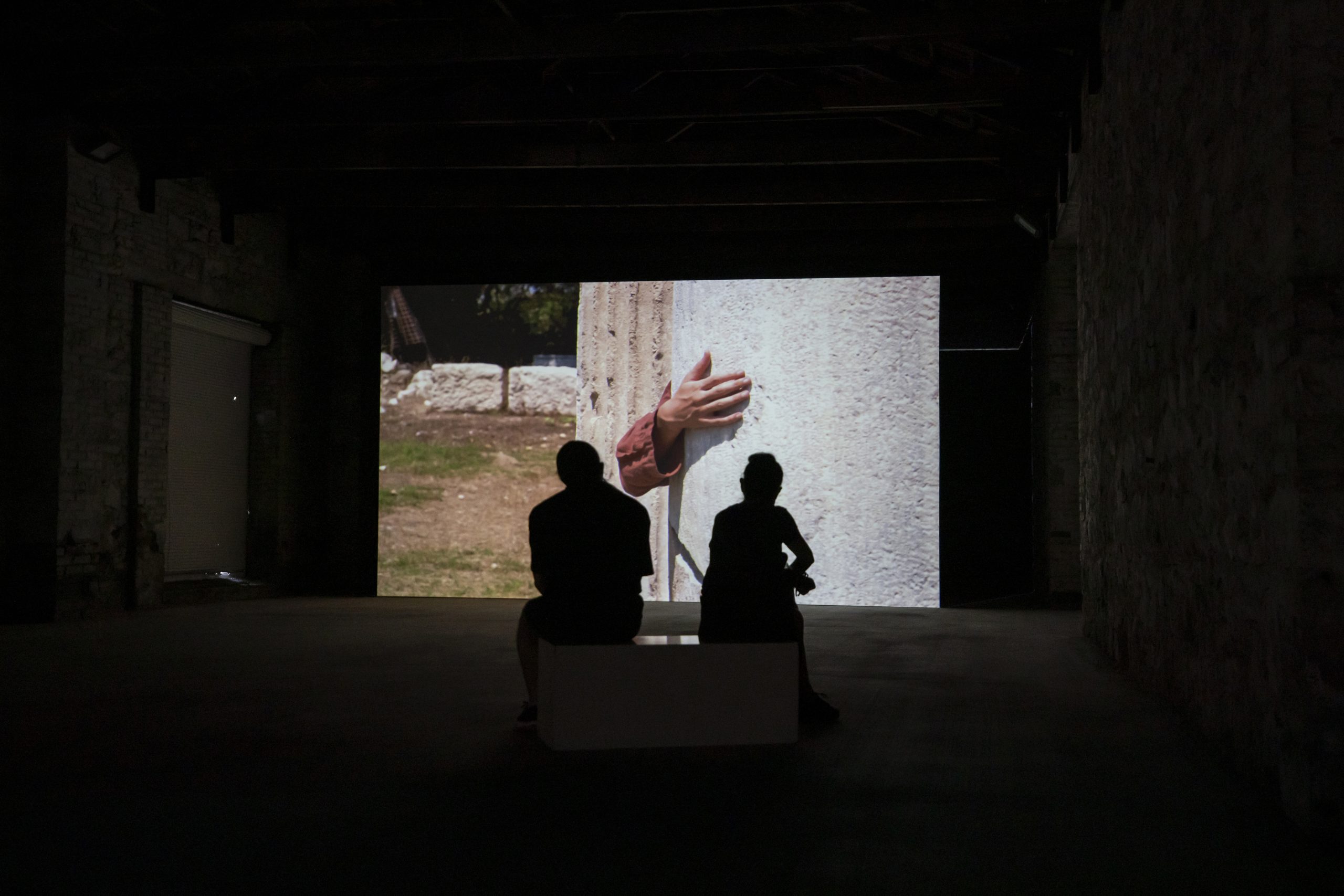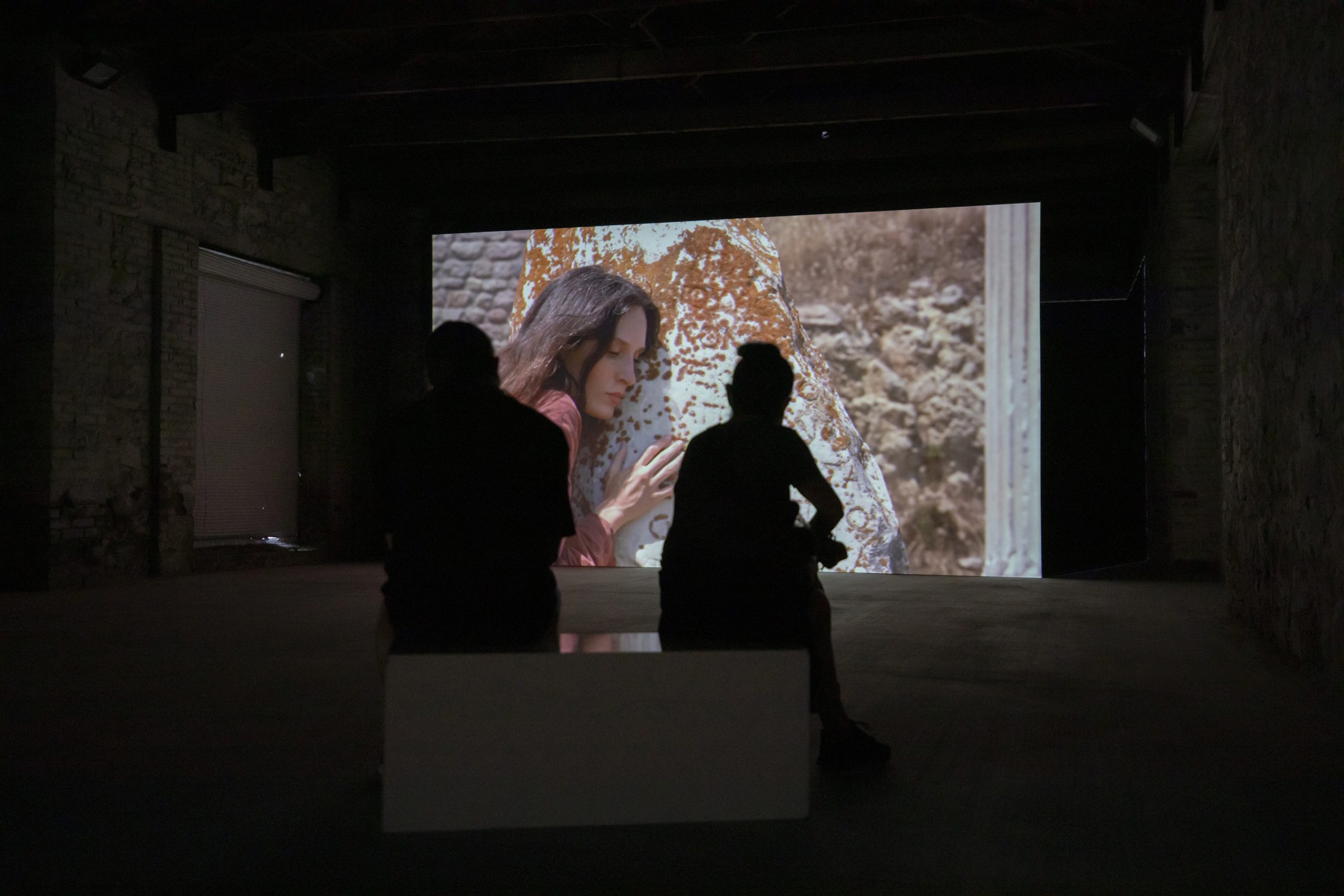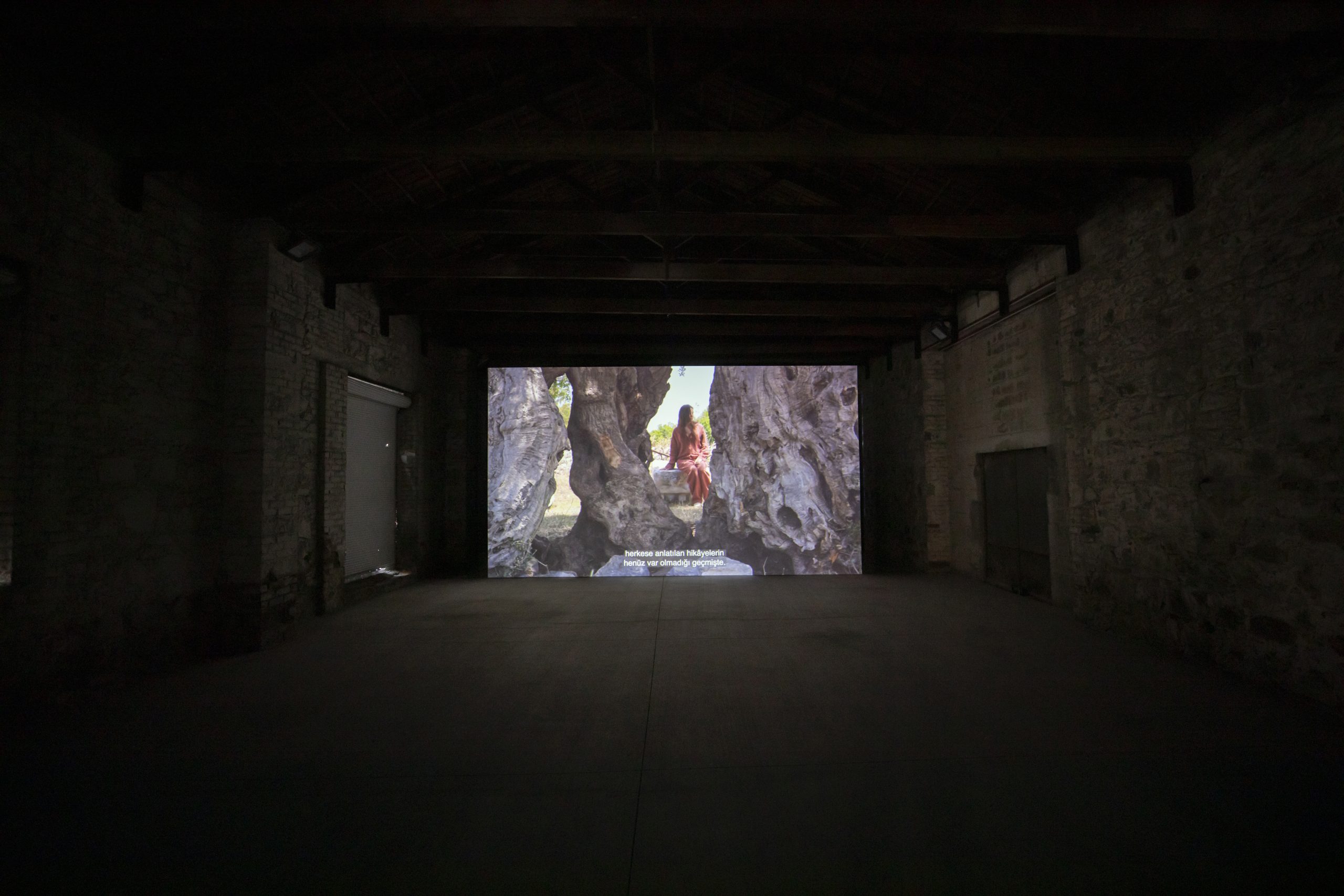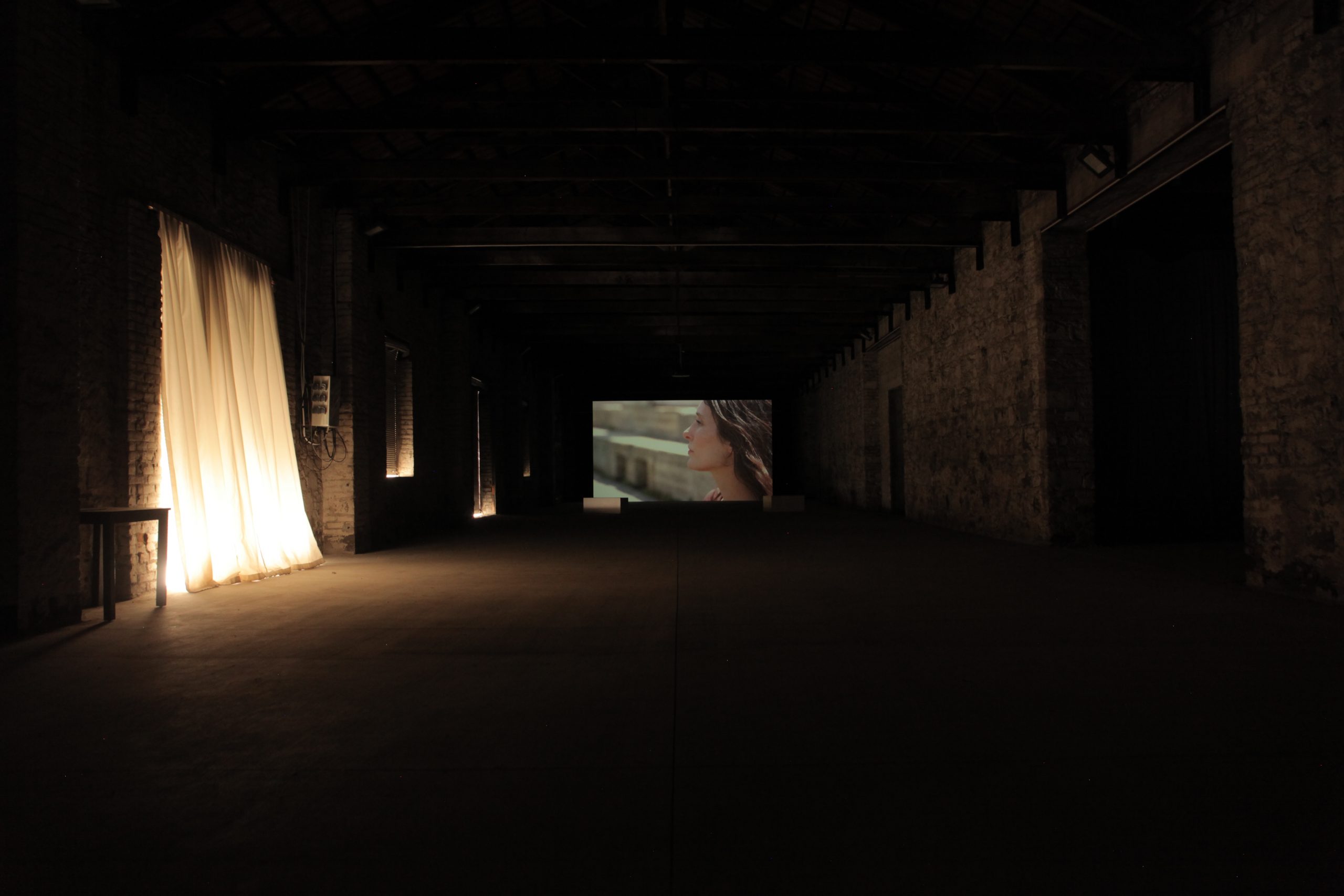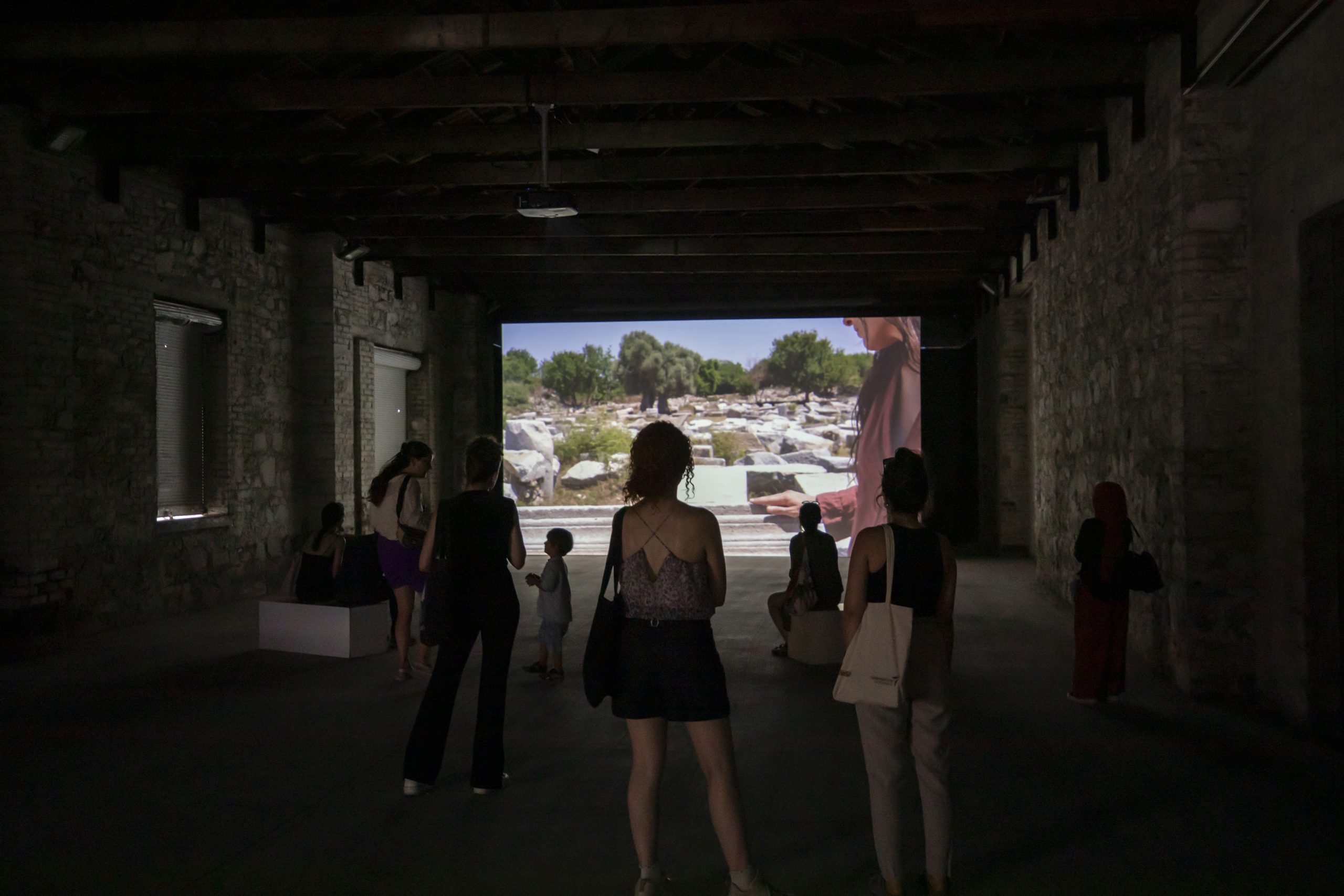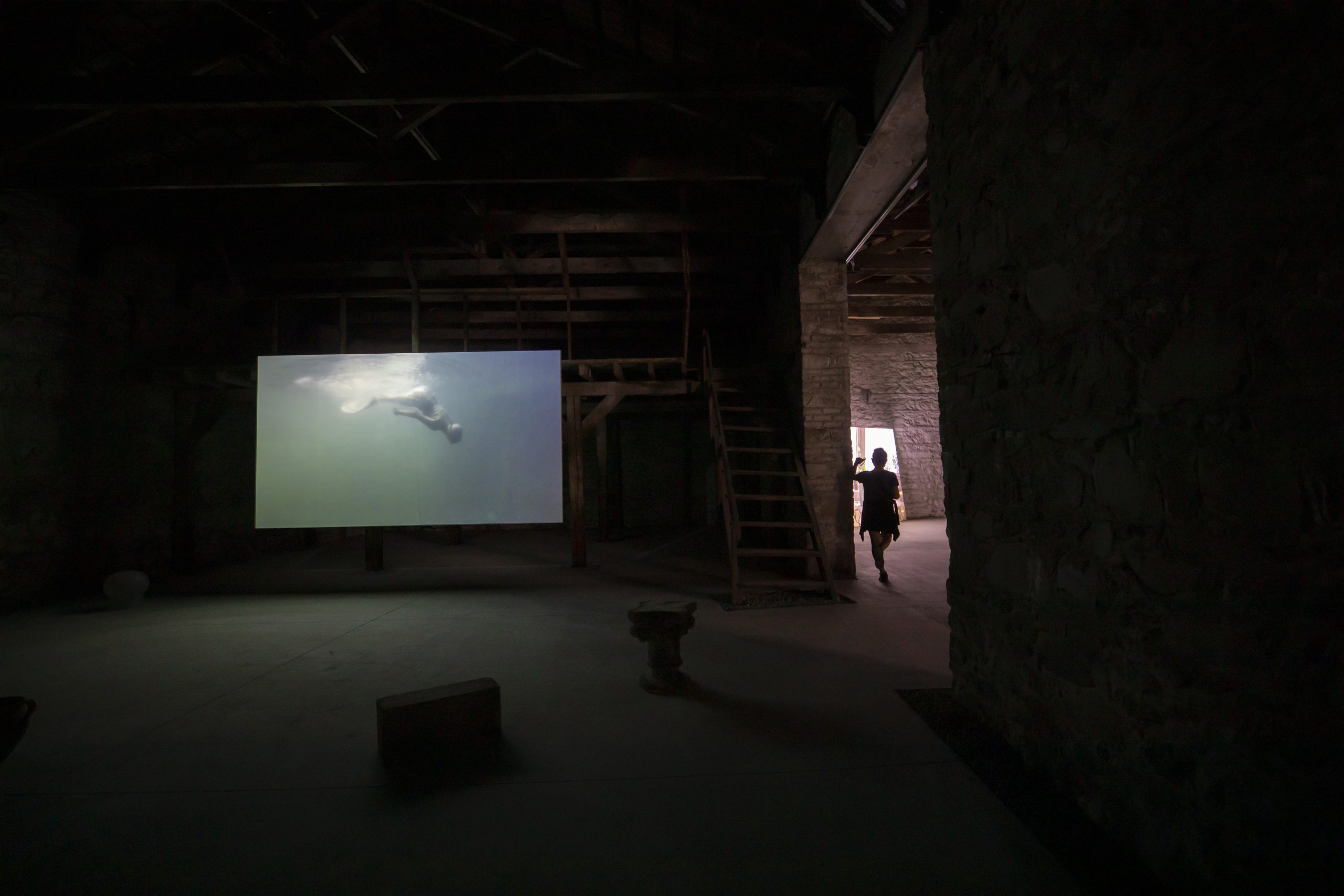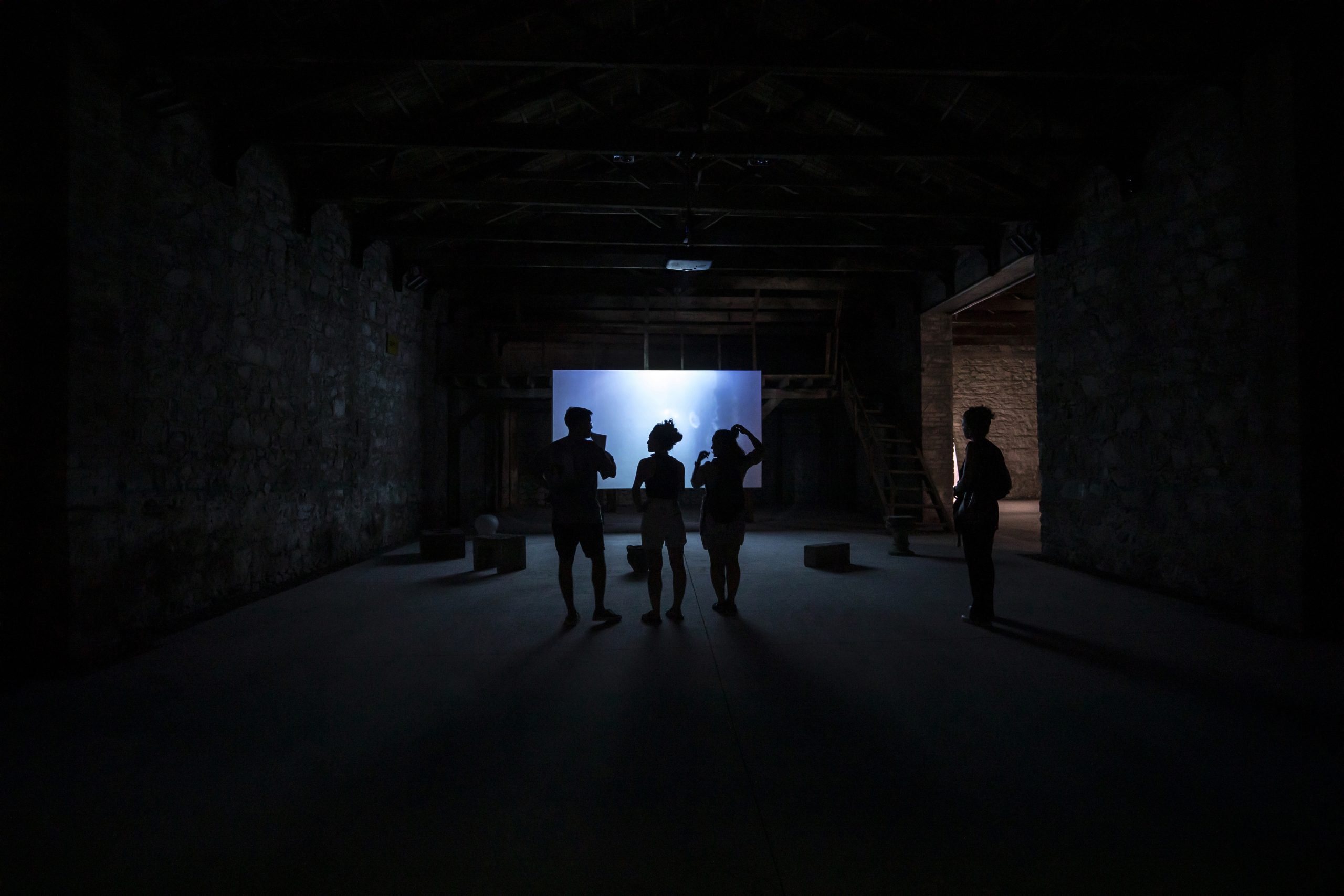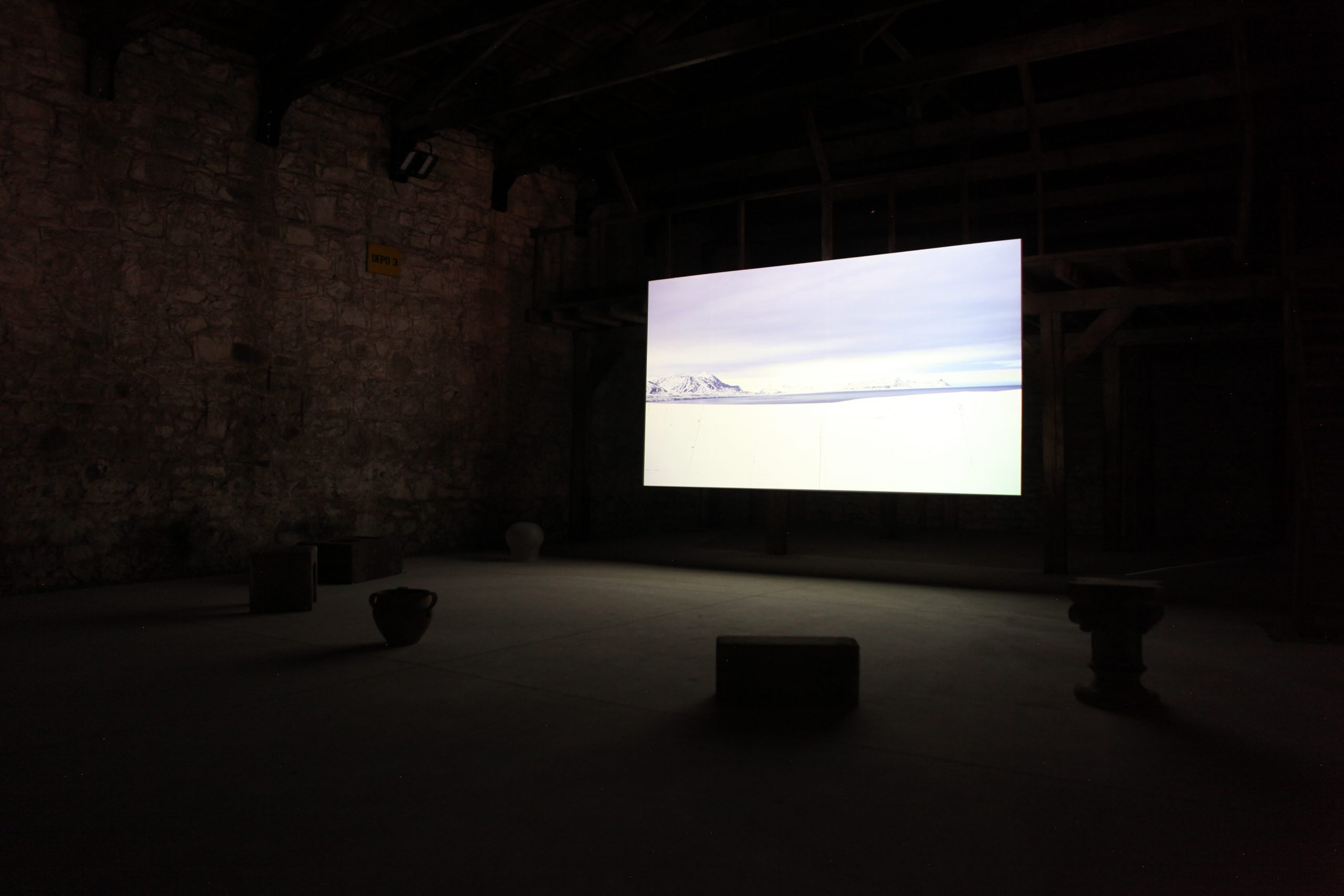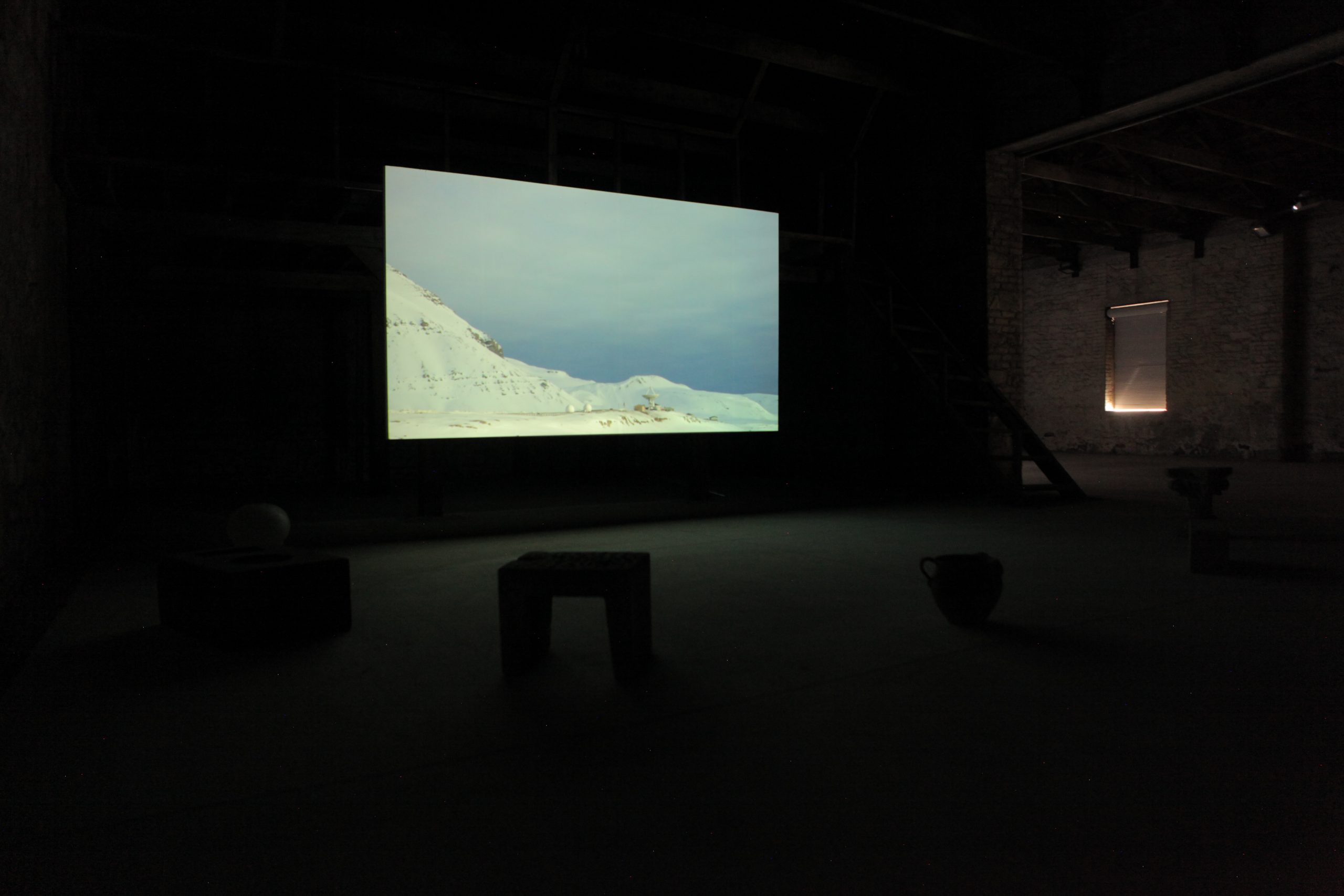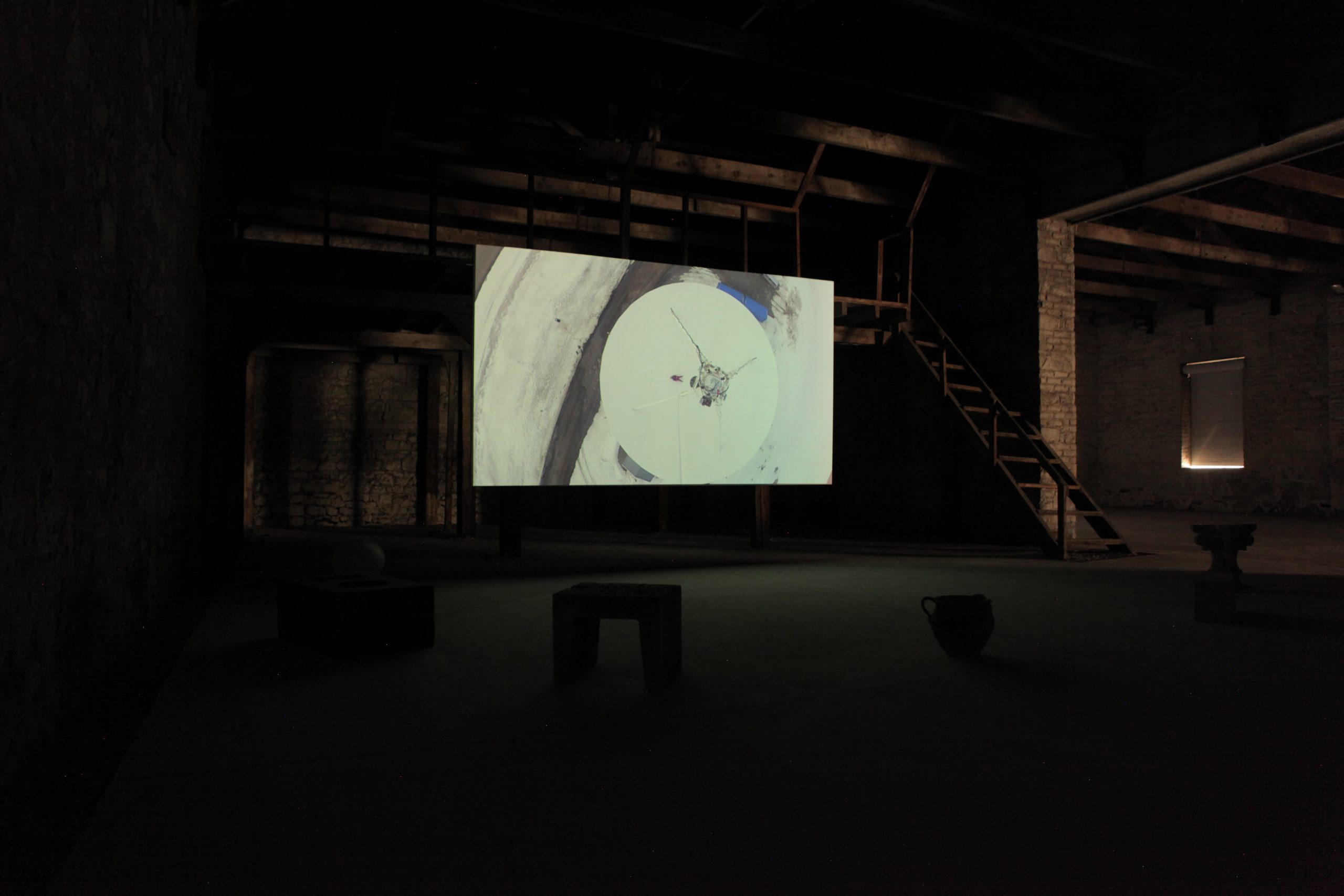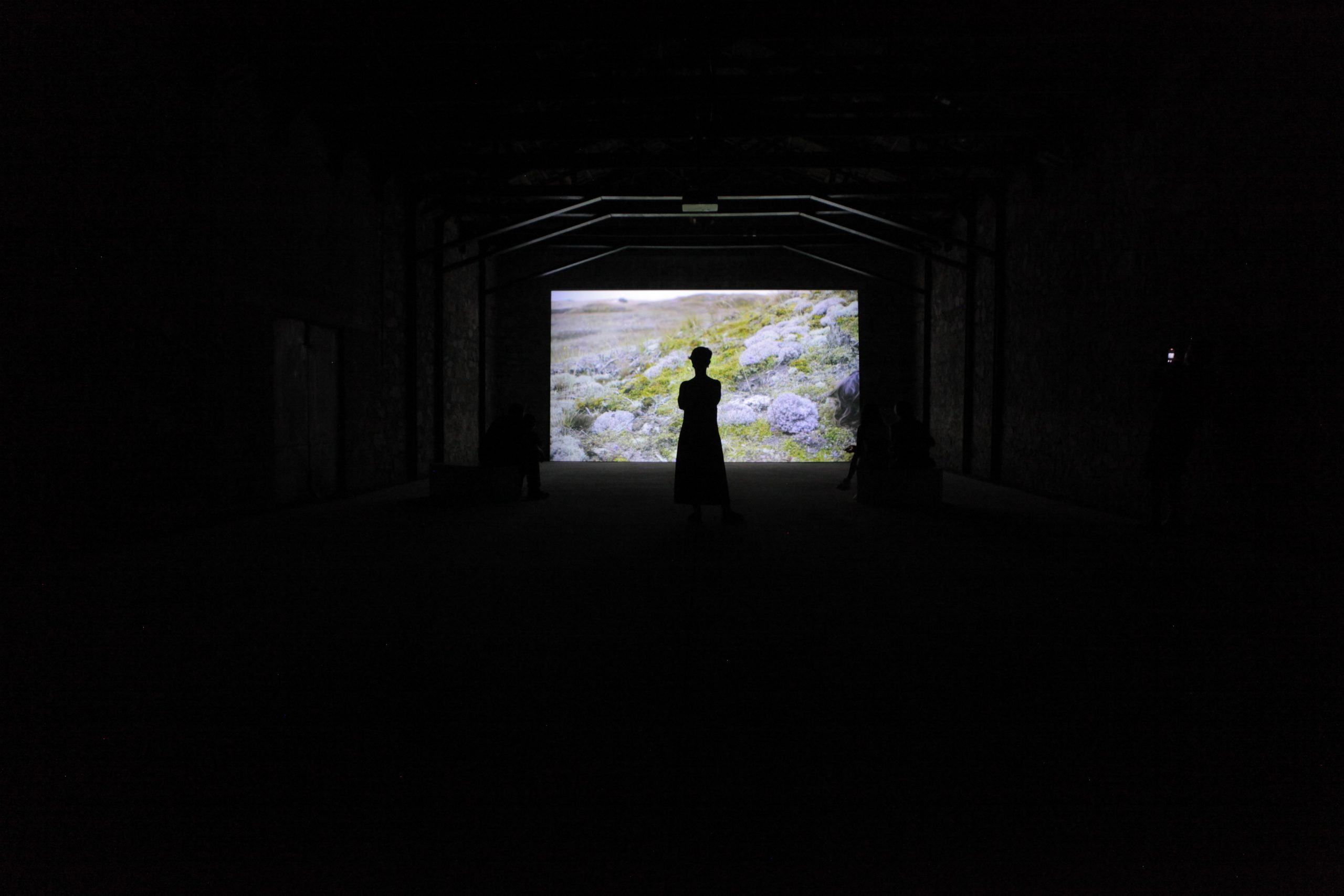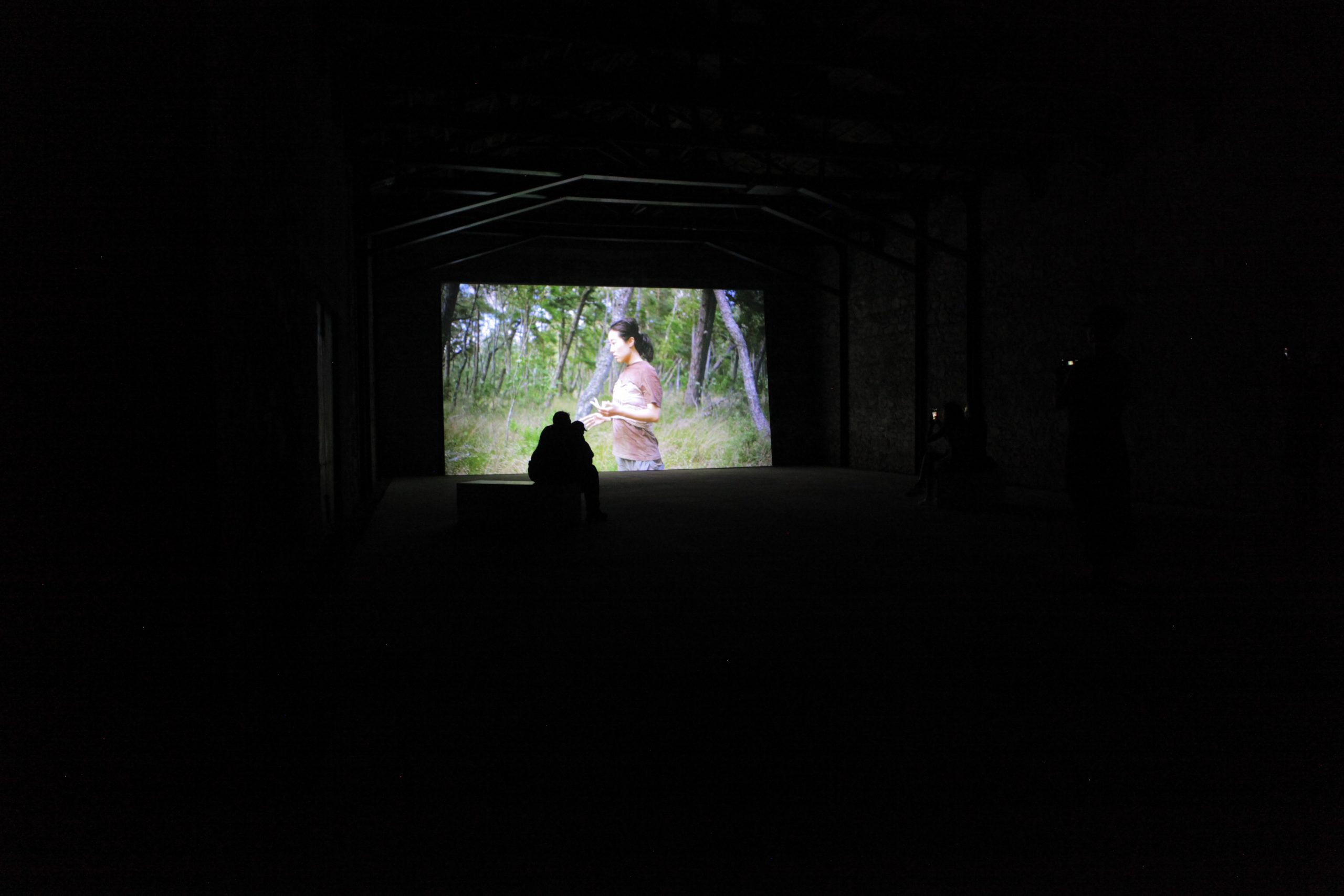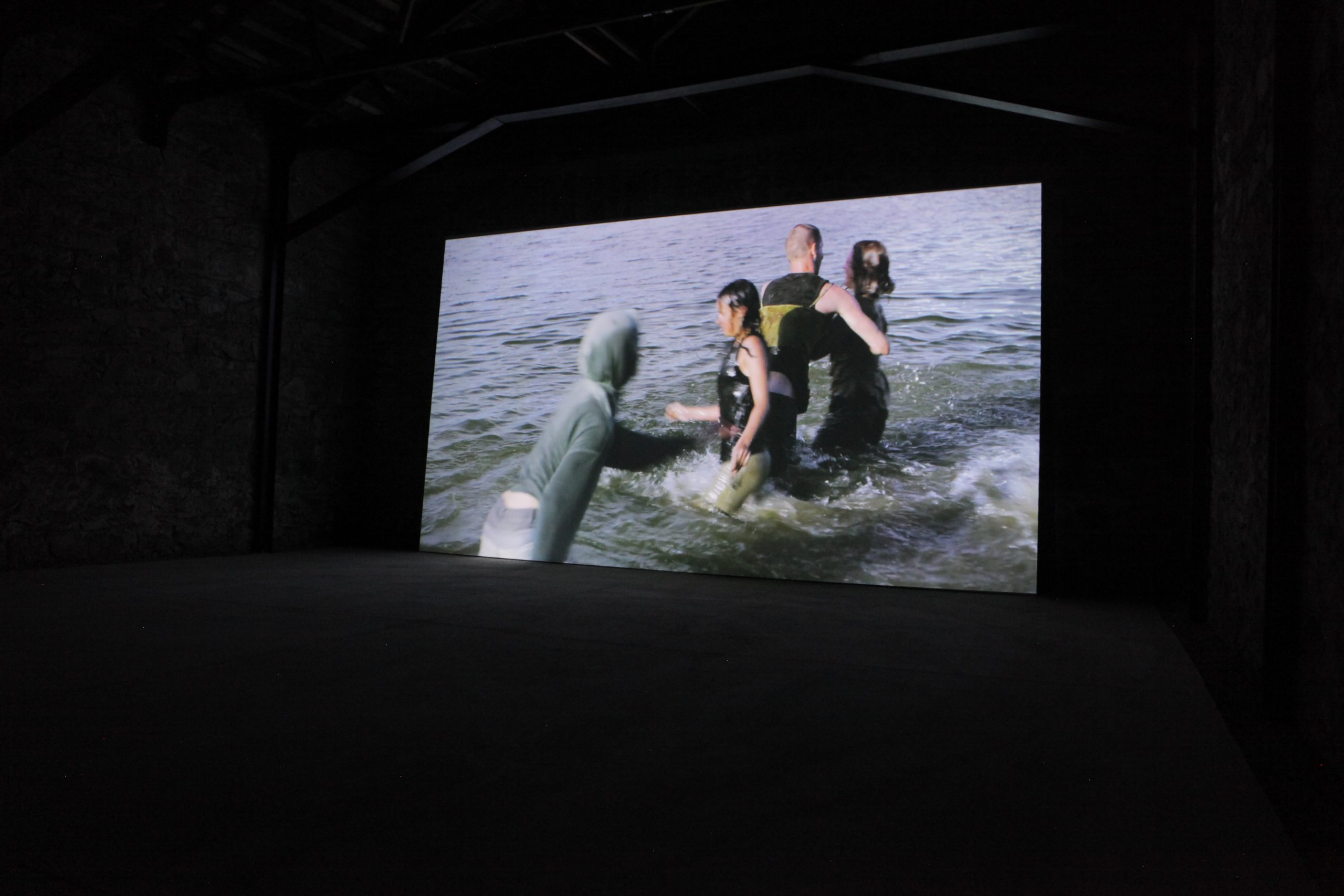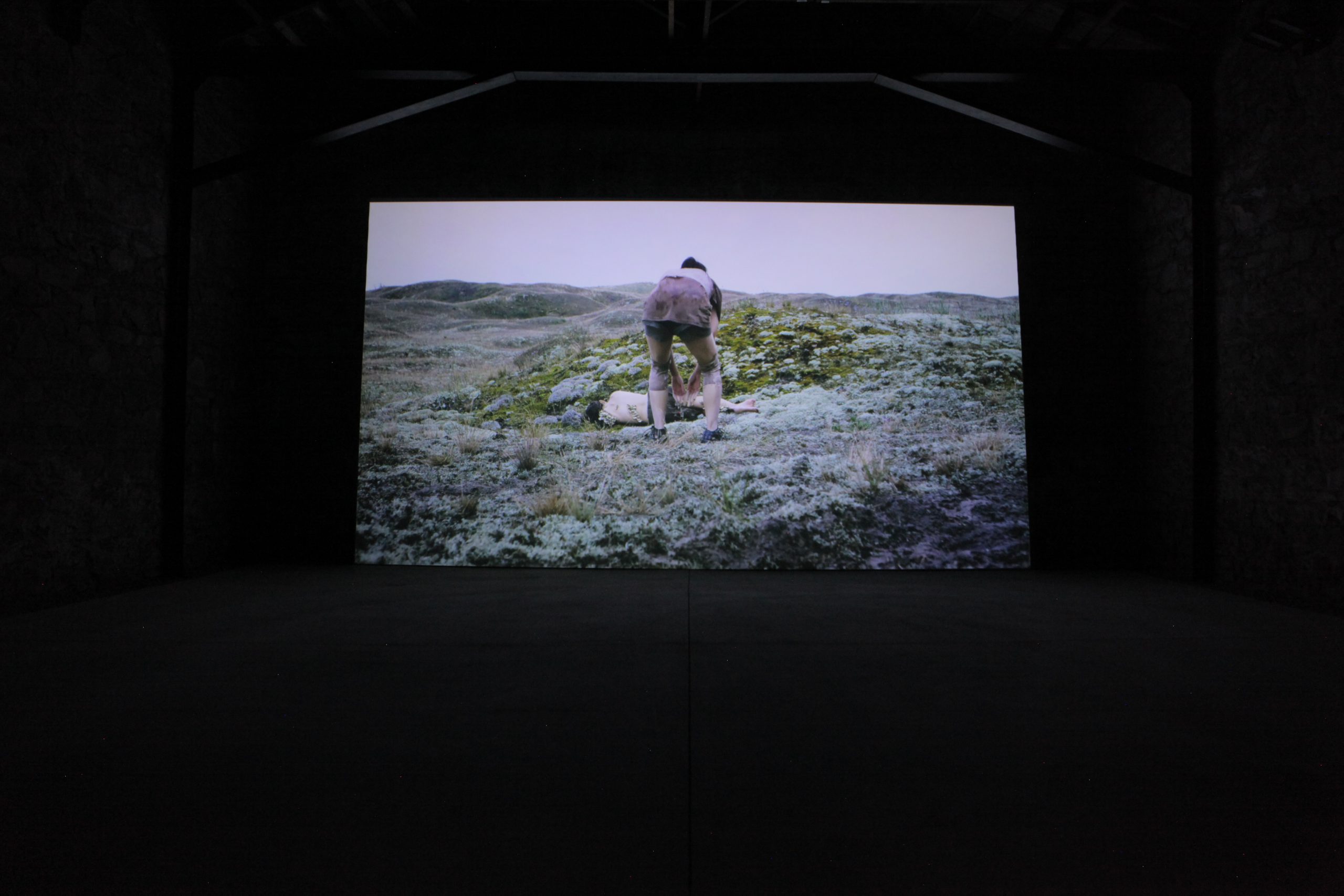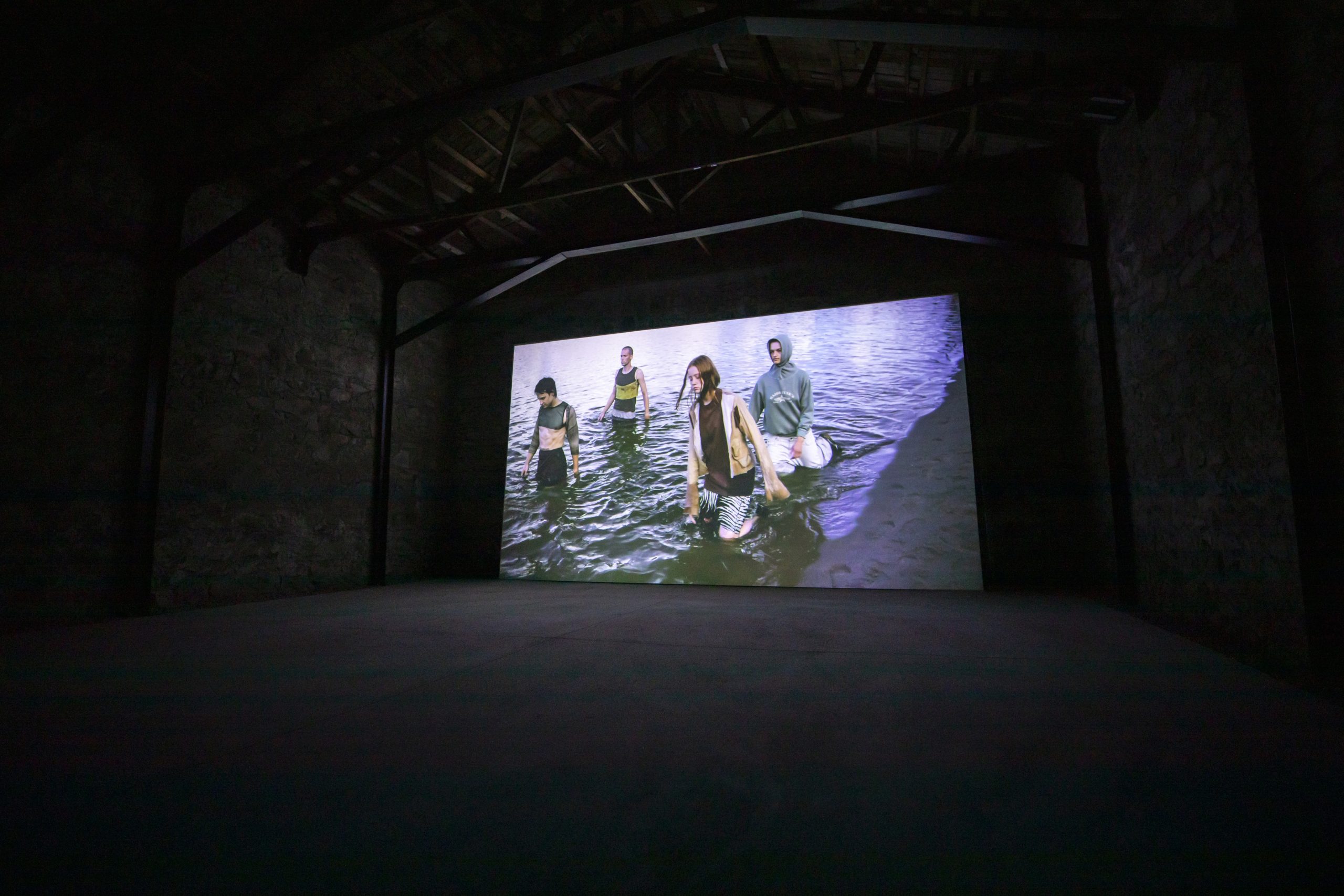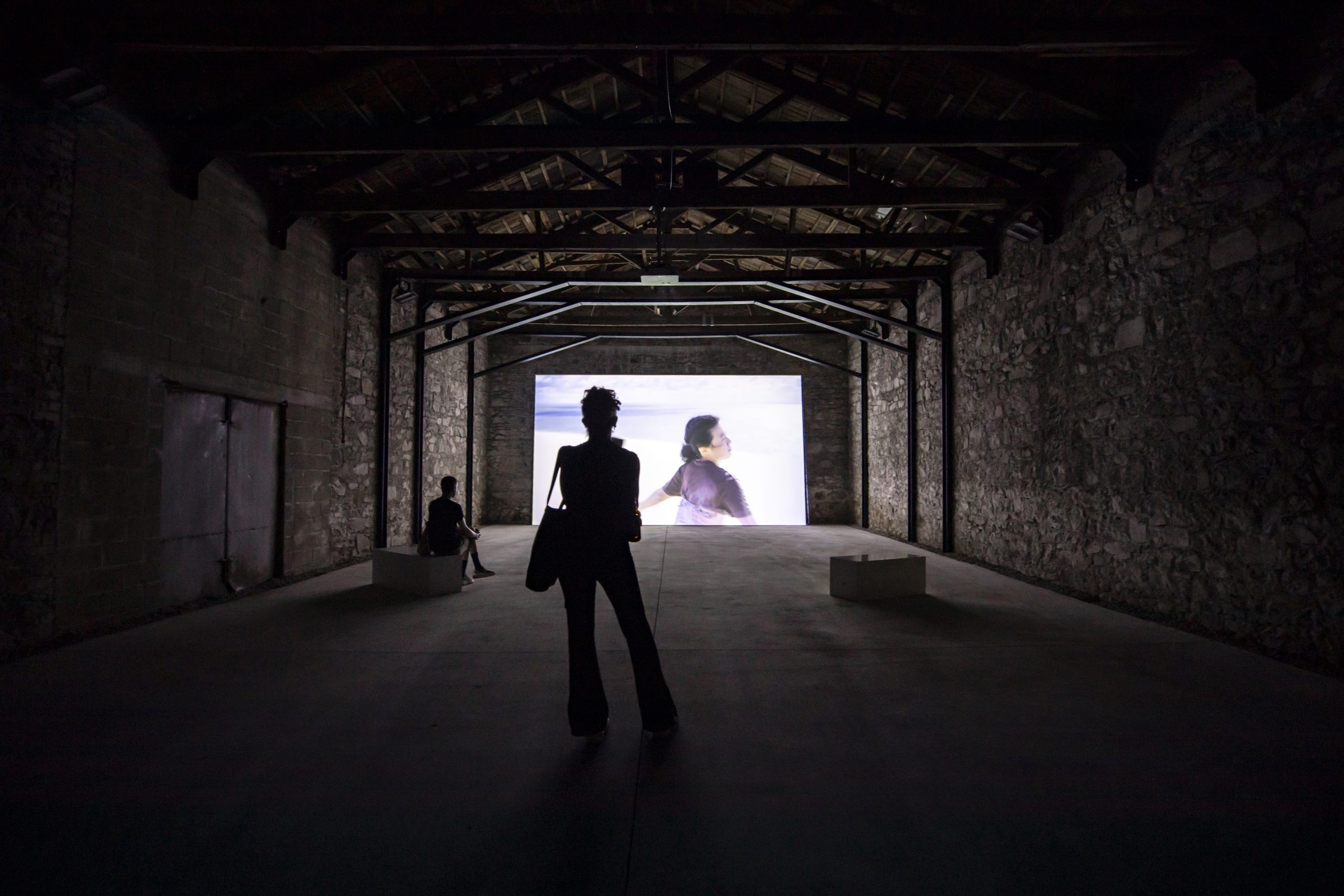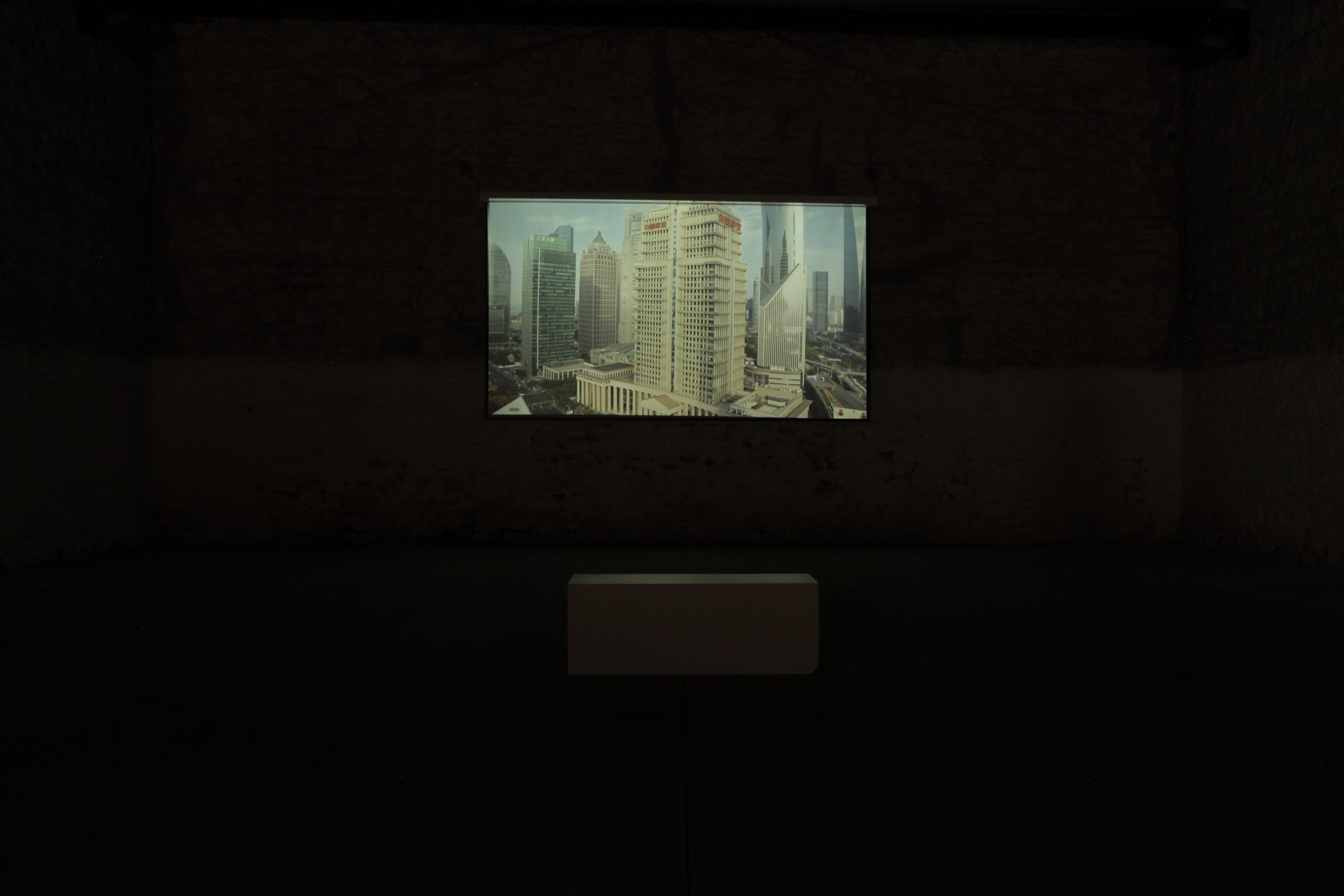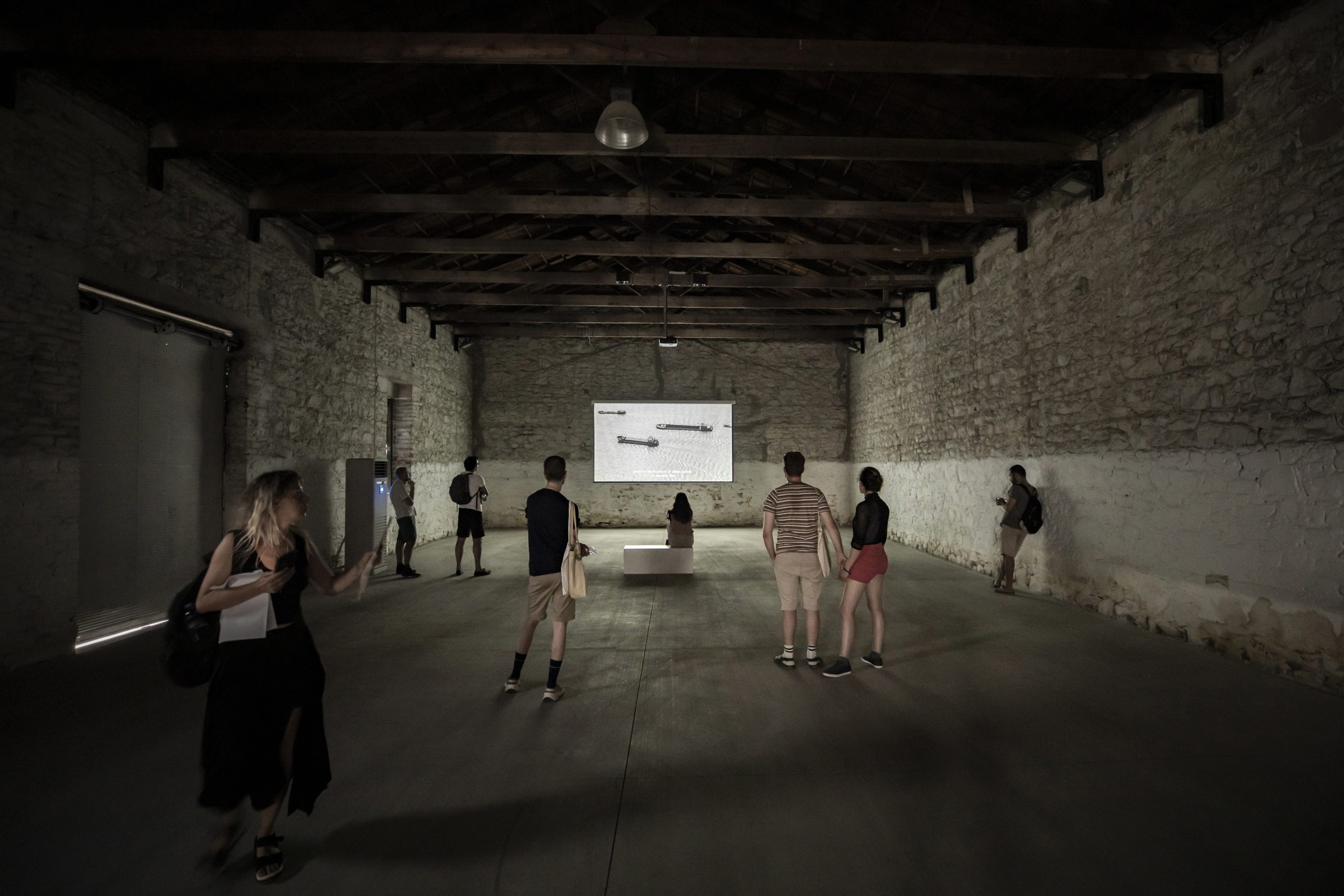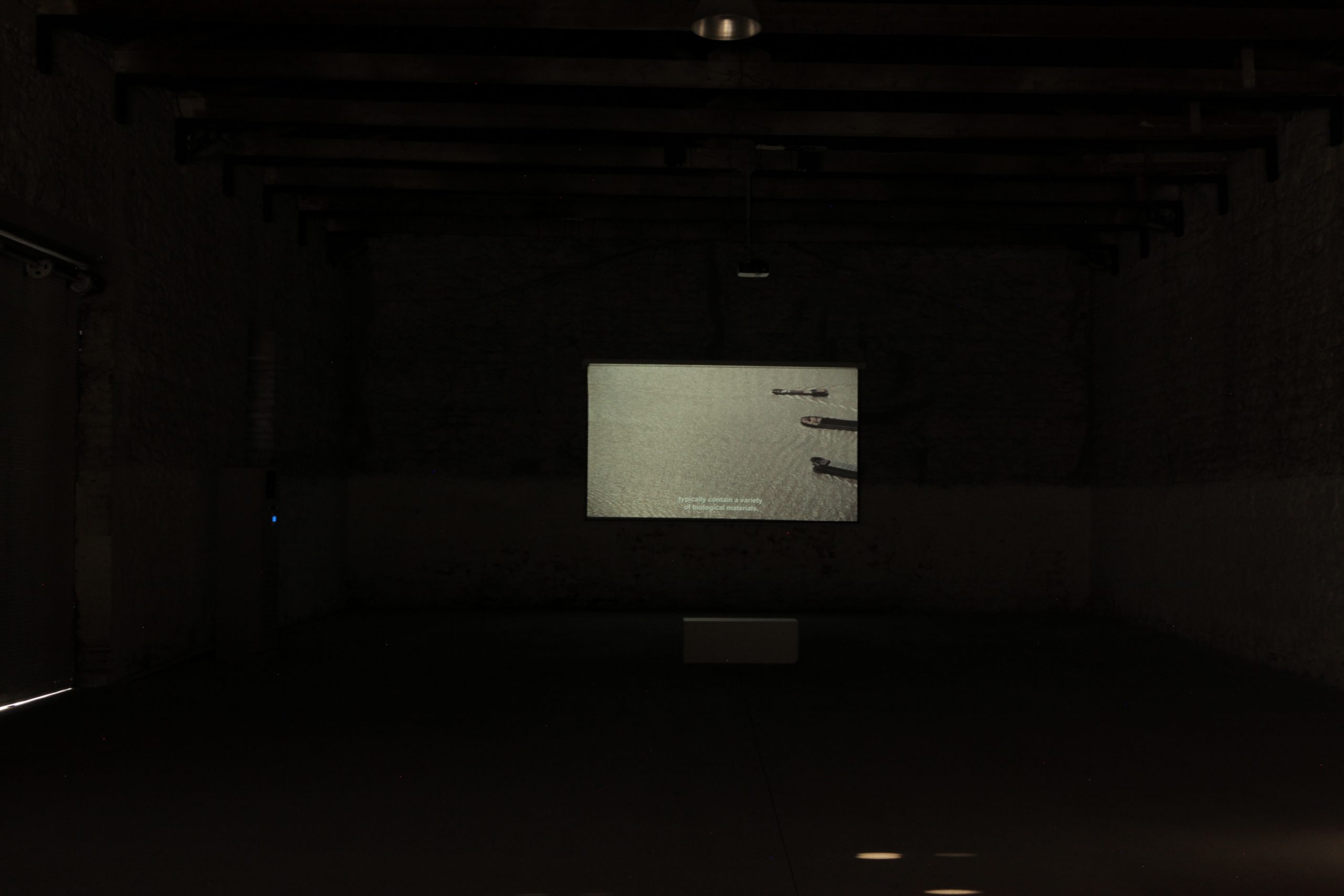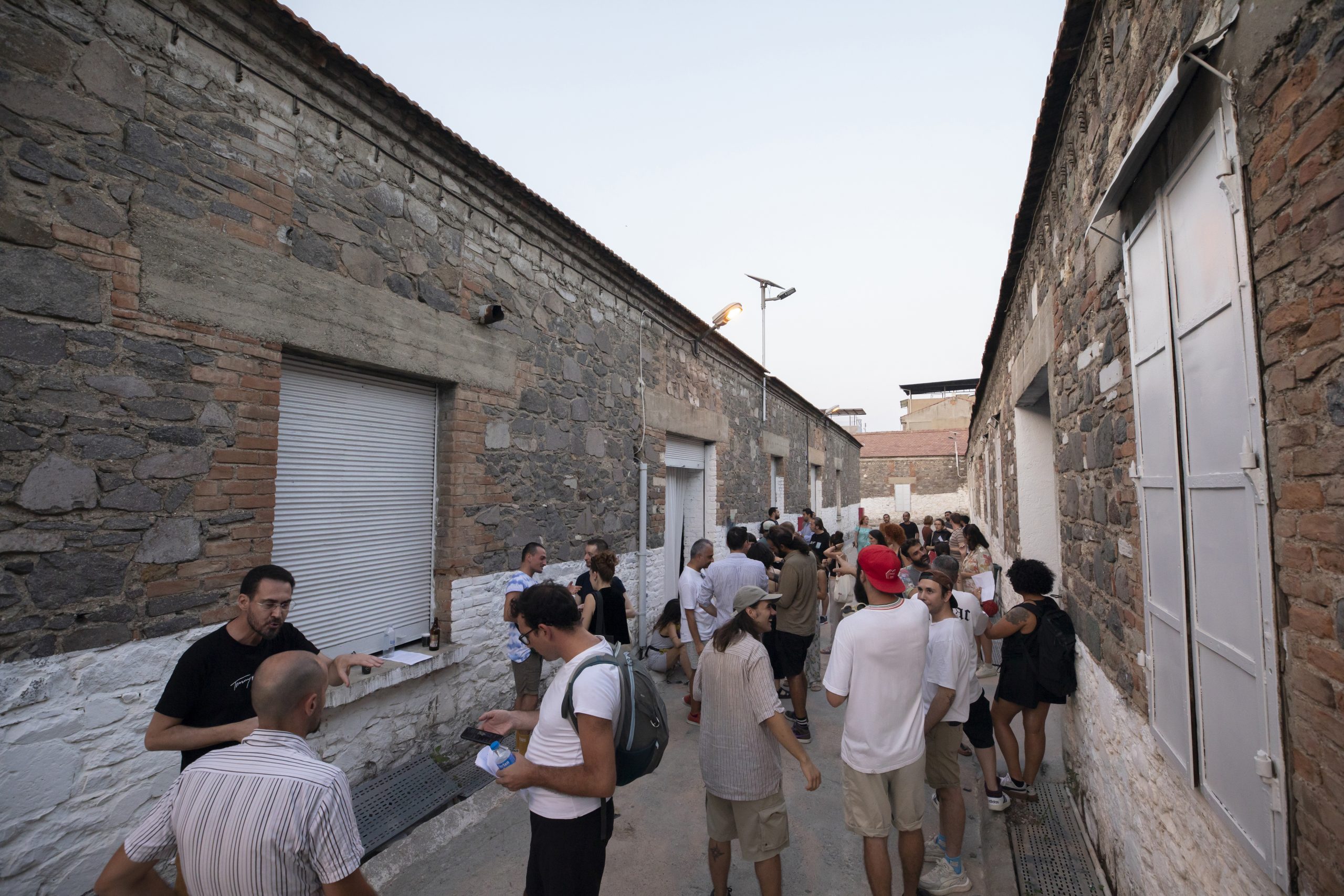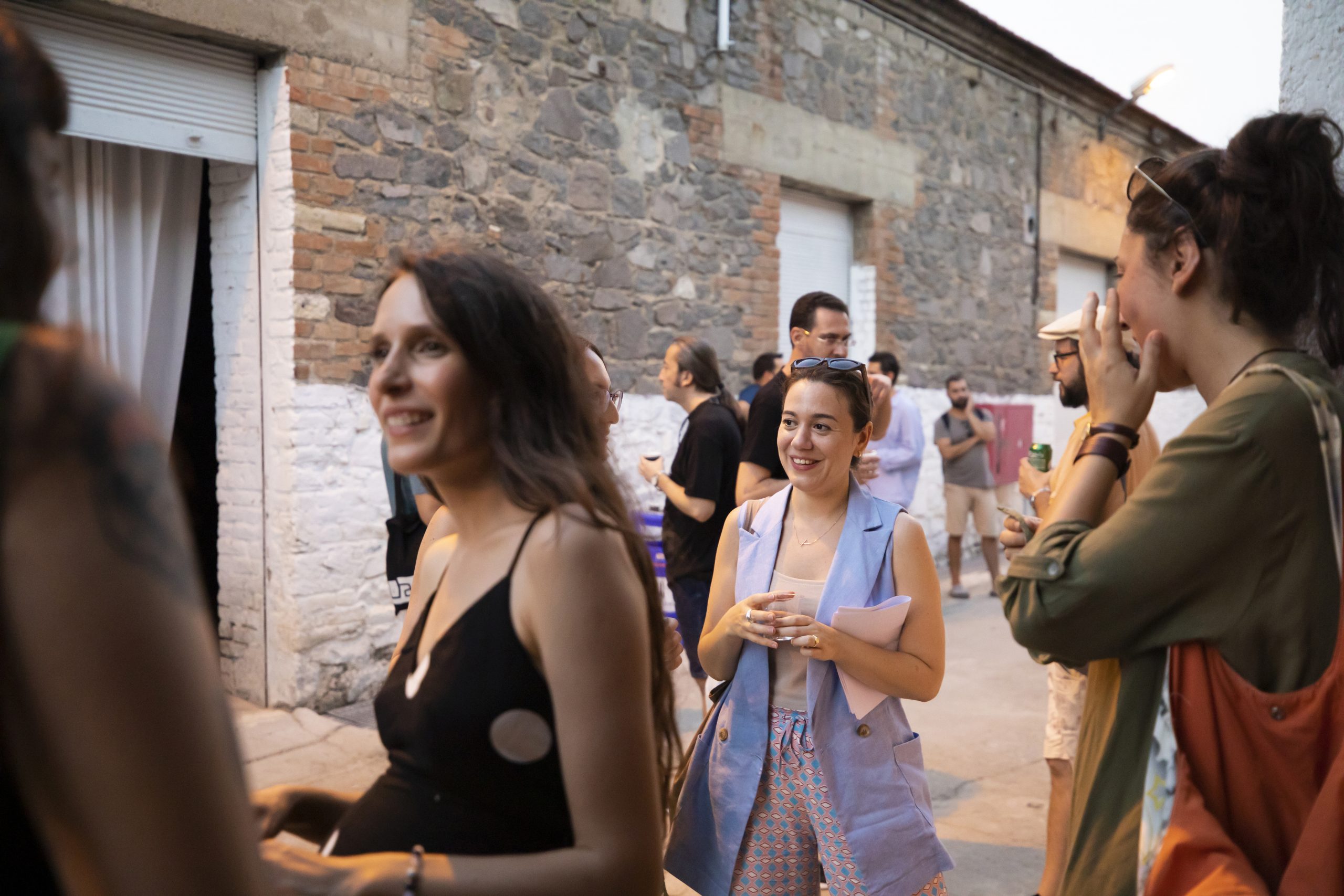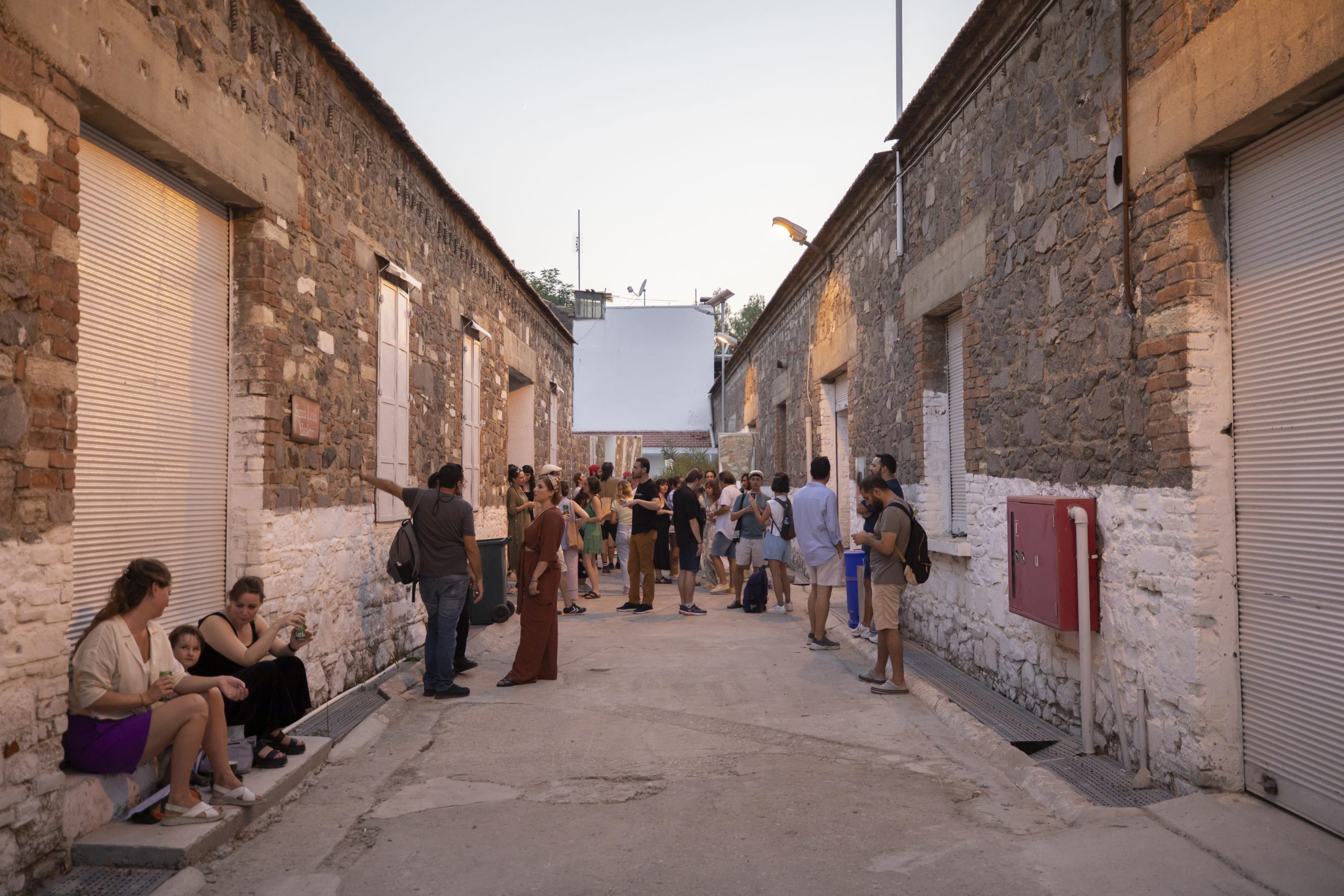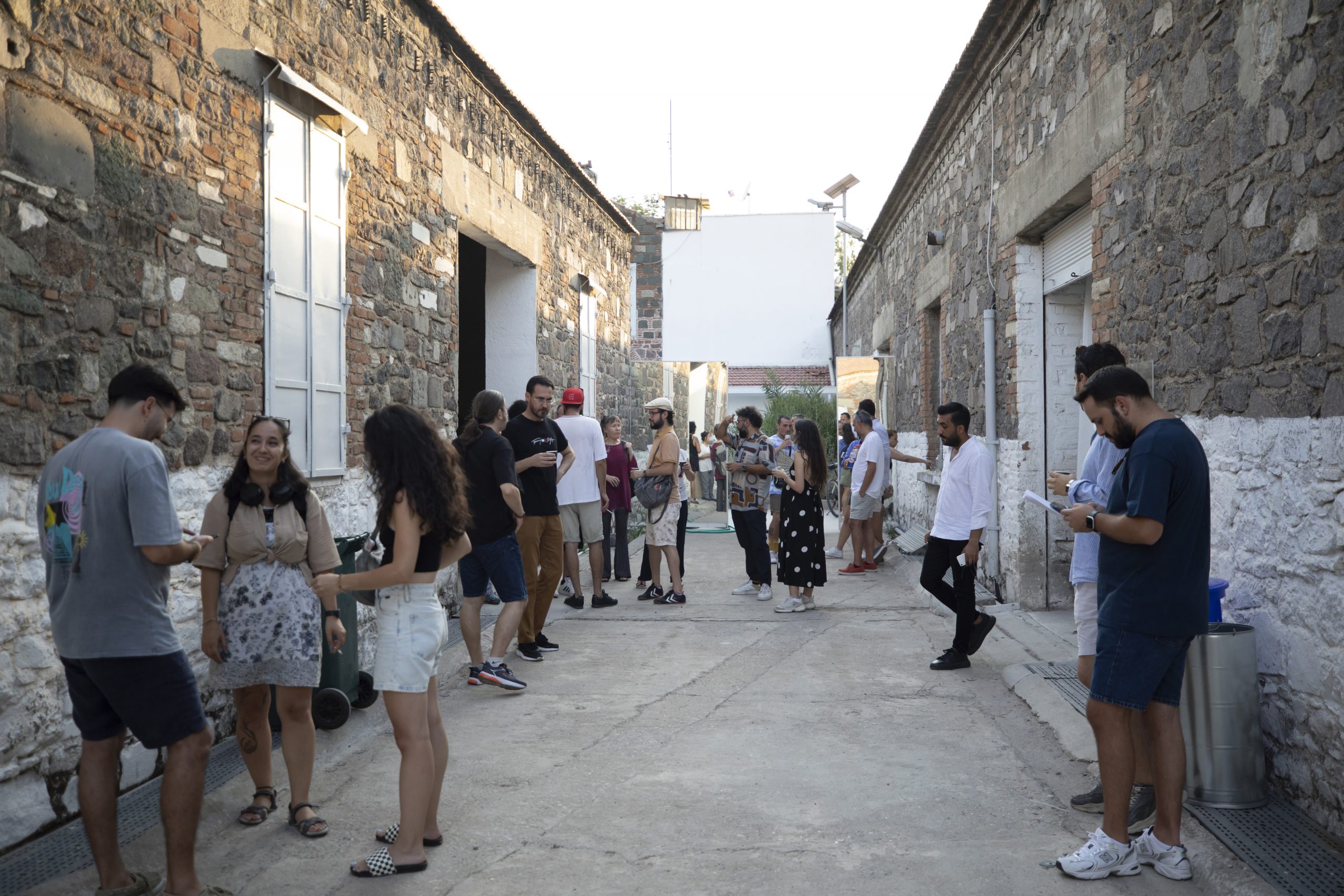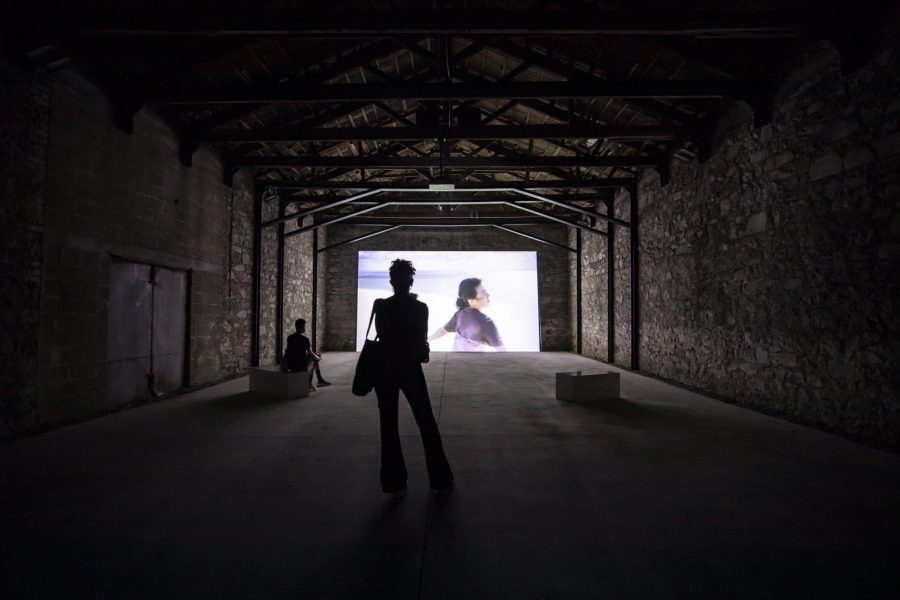Hiçbir şey filizlenmediğinde sen hayatta kaldın
Tarihi Bıçakçı Han
19.08 – 10.09.2023
Monitor “Hiçbir şey filizlenmediğinde sen hayatta kaldın” başlığını taşıyan sergisinde Eglė Budvytytė, Özgür Demirci ve Emilija Škarnulytė’nin çalışmalarını bir araya getiriyor. Sergi, SAHA Derneği’nin bağımsız sanat inisiyatiflerinin sürdürülebilirliğine yönelik fonu ve İzmir Büyükşehir Belediyesi’nin desteğiyle 19 Ağustos – 10 Eylül 2023 tarihleri arasında Tarihi Bıçakçı Han’da izleyiciyle buluşuyor. Bu sergiye paralel olarak Monitor bu yıl, Uluslararası Güney Amerika Çağdaş Sanat Bienali BIENALSUR ile kurduğu işbirliği kapsamında Florencia Incarbone’nin küratörlüğünde Florencia Levy’nin “Fossil Place” isimli video çalışmasının gösterimine ev sahipliği yapıyor. Monitor’un sergisiyle aynı tarihler arasında ve aynı mekânda yer alacak gösterimde, insanlığın olası geleceğine dair bir bakış açısı sunuluyor.
Kendini ışığa yönlendiren hâlin yerin altında duruyor. Bir başkası ona ulaşmaya çalıştıkça bütünlüğüne zarar veriyor. Yekpare çıkamayacağını biliyorsun, içini ısıtan duyuların artık çalışmıyor. Günün aydınlanışı da batışı da buraya uzak topraklarda. Sesi yok, kokusu yok, şekli yumru biçiminde. Yumrulardan bir boğaz getirip yüreğine bağlıyorlar, hiçbir şey dile gelmiyor. Taş üstünde taş, altında taş, orada sen varsın. “Hiçbir şey filizlenmediğinde sen hayatta kaldın”, yaşamsal ihtiyaçların karşılanmadığı bir düzende varlığın sürekliliğinin imkânı üzerine düşünüyor. Sergi, artık burada olmayanların ve form değiştirerek varlığını sürdürenlerin kalıntılarından öğrenebileceklerimize bakmayı öneriyor.
Özgür Demirci’nin “Vaatler Antolojisi” projesi kapsamında ürettiği “Terk Edilmişler” ve “Başlangıçtan Beri” isimli çalışmaları tutulmamış sözler ve unutulan mitler arasında dolaşır. Varlıklarını sürdürebilmek için yeterli suya ulaşamayan bitkilerin toprağa tutunmaya çalıştığı “Terk Edilmişler” çalışması, yerine getirilmeyen vaatlere karşılık yalnızca günü kurtarmaya yetecek kadarına muhtaç bırakılma durumundan yola çıkarak şekillenir. Elimizden alınanların ardından geriye kalan yaşamın kaynağı nerede başlayıp nerede sona erer? “Başlangıçtan Beri” ismini
taşıyan çalışmasında Demirci geçmiş hikâyelere bakarak bu sorunun yanıtını arar. Mitler ve yalancı öykülerin insan davranışını şekillendiren yanlarından beslenen “Başlangıçtan Beri”, tarihi yazmak için kelimeleri yaratan bellek tanrıçası Mnemosyne karakteri üzerinden dünya düzeninin geldiği yeri sorgular. Antik kentlerde yürüyüp sesleri dinleyen karakter, dünyanın kaybettiği enerjisini yeniden açığa çıkaracak hikâyeleri duymaya çalışır. Bu kentlerden geriye kalanlar, dünya düzeninde var olmaya çalışan gerçek hikâyeleri oluşturur. Toplumlara anlatılan yalancı öyküler gerçek hikâyelerin yerini aldığından bu kentlerde görünen çoğu şey paramparça hâldedir. Mnemosyne burada değilken sözcükleri bütünün zararına kullananlar anlattıkları hikâyelerle toplumu tuzağa düşüren fikirleri destekler. Kelimeler tarihin seyrini etkileyecek şekilde kullanılır. Tüm bunların yıkıcı etkisi kent ve kültürü yerle bir ederek gerçek olanı toprağın alt katmanına iter. Yanan kitaplar, kaybolan sözcükler, kökene dair ne varsa hepsi taşın, toprağın, suyun ve havanın derinliklerinde mevcuttur. Demirci bu çalışmasıyla bugün dünyanın sahip olduğu enerjiyi yitirmesine sebep olan, toplumu şekillendiren ve yöneten sistemin kökenini araştırır. Toplumların geçmişten günümüze örgütleniş ve yaşayış biçimlerini anlamak bugün içinde bulunduğumuz sistem karşısında varoluş yöntemleri geliştirmenin yolunu oluşturur.
Emilija Škarnulytė olası insan sonrası mitolojileri varsaydığı “Sirenomelia” başlıklı çalışmasında Kuzey Kutbu’nun sularında gizlenen Soğuk Savaş kalıntılarınının peşine düşer. Kendi bedenini mitolojik bir karakter olan Siren’e dönüştürerek Norveç’te bulunan NATO askeri üssünün sonsuzluk havuzlarında gezinen sanatçı, insanın okyanusun dibinde açtığı yaraları görmeye çalışır. Škarnulytė, hâlâ savaş mitini koruyan düşünce yapısına karşı mit olarak mutasyona uğramış Siren karakterini sunar. Alışılmış mitolojik hikâyelerin tersine bu çalışmada Siren’in sesi duyulmaz. Onun sessizliği ekolokasyon sinyallerine dönüşerek suyun altında yankılanır. Yavaşlatılmış beyaz gürültü ve Soğuk Savaş dönemi radyo frekansları da sanatçı tarafından çalışma boyunca duyuları harekete geçiren bir unsur olarak “Sirenomelia”da yer alır. Siren, geçmişin geleceğe bağlandığı bu çalışma boyunca rehberliğiyle görünmeyeni algılanır kılmaya çalışır. Evrene dair bugüne dek bilinenlerin sınırını zorlayan Atlas Deneyi, evreni anlamak için çıkılmış en hızlı yolculuk olarak gösterilir. Bugüne dek ona yüklenmemiş anlamların peşine düşmek, en büyük parçadan en küçüğüne doğru çıkılan yolculukla her geçen gün yeni keşifler doğurur. Bütünün algımız dışında kalan anlamına erişebilmek için onu oluşturan tüm parçaları görebilmek gerekir. Evreni anlamak için yapılan parçalar arası yolculuk gibi, Siren karakterinin yüzeyin altındaki gizemli dünyalara açılan yolculuğu varlığımızı ve yok oluşu anlamamız için olanak sağlar. İnsanın sebep olduğu tüm yıkıma rağmen suyun altındaki oluşumlarla ortaya çıkan yeni bilinç durumları yeni bir hikâye anlatımını doğurur. Škarnulytė, insan ve insandışı varlıkların
ilişkilerinin şekil değiştirmesiyle tarihi yeniden yazmak ister. Bu alternatif tarih, insan olmayan varlıkların kendini evinde hissedebileceği bir düzene sahiptir.
Eglė Budvytytė, Marija Olšauskaitė ve Julija Steponaitytė işbirliğiyle ürettiği “Songs from the compost: mutating bodies, imploding stars” başlıklı çalışmasında, bugünkü dünya düzeni içinde yaşam döngüsünün sürekliliği için simbiyoz, mutasyon ve hibriditeyi önerir. Curonian’daki çam ormanları ve kum tepelerinde çekilen video karşılıklı bağımlılık yasası üzerinden insan dışı bilinç biçimlerini keşfe çıkar. Sanatçının biyolog Lynn Margulis ve bilim kurgu yazarı Octavia E. Butler’ın çalışmalarından ilhamla şekillendirdiği şarkısının eşlik ettiği çalışma, sözcüklerin yaratıcı titreşimiyle bedenin hareketini buluşturur. Bu buluşma, yaşam ve çürüme arasındaki ilişkiyi açığa çıkarır. Koreografideki yataylık, insan figürünün alışılagelmiş dikeyliğini bozup onu manzaranın içine dahil eder. Toprağa ve birbirine doğru çekilen bedenler hiyerarşik sisteme karşı duruş olarak ortakyaşamın varlığını besler. Mitolojide sürekli dönüşüme uğrayan karakterler mutasyona uğramış bakteriler gibi yaşamlarını farklı formlarda sürdürür. Mitlerde sıklıkla karşılaşılan şekil değiştirme kimi zaman cezalandırılma amacı taşısa da sıklıkla zor durumdan kurtarılmayla da ilişkilidir. Bitkiye, toprağa, hayvana dönüşmenin yanı sıra mitolojik hikâyelerde karşılaşılan çoğu şekil değiştirme taşa dönüşmedir. Budvytytė’in çalışmasında mitolojik hikâyelerden farklı olarak dönüşüm ağır biçimde gerçekleşir. Taşın bilgeliği insanı dönüşümün farkına varmaya davet eder. “Songs from the compost: mutating bodies, imploding stars” karşılıklı bağımlılık, teslimiyet, ölüm ve çürüme meseleleri üzerinden simbiyotik yaşamın farklı boyutlarının keşfine açılır.
Mircea Eliade’ye göre yeni bir yaşamın başlayışının kutlanması, kozmogoni mitinin düzenli aralıklarla yinelenmesine olan ihtiyaçtan kaynaklanır.* Her ne kadar modern insan arkaik toplumlardakilerden farklı olarak bu geleneği bilinçsiz bir şekilde sürdürse de bu girişimler dünyayı oluştuğu günkü enerjisine kavuşturma niyeti taşır. “Hiçbir şey filizlenmediğinde sen hayatta kaldın” başlıklı sergi farklı varlık biçimlerinin kökenine inerek kozmogoni mitini desteklemeye çalışıyor.
* Mircea Eliade, Mitler, Rüyalar ve Gizemler, Çev. Cem Soydemir, Doğu Batı Yayınları, Ankara, 2017, s. 27.
//
You survived when nothing grew
Historic Bıçakçı Han
19.08 – 10.09.2023
Monitor brings together the works of Eglė Budvytytė, Özgür Demirci, and Emilija Škarnulytė in the exhibition titled “You survived when nothing grew”. The exhibition will be on view at the Historic Bıçakçı Han between August 19th and September 10th 2023 with the support of SAHA Association’s fund for the sustainability of independent art initiatives and Izmir Metropolitan Municipality. In parallel with this exhibition, Monitor is hosting the screening of Florencia Levy’s video work “Fossil Place,” curated by Florencia Incarbone as part of its collaboration with BIENALSUR, the International Biennial of Contemporary Art of the South. The screening, which will take place on the same dates and in the same space as Monitor’s exhibition, offers a perspective on the possible future of humanity.
The version of yourself that guides you to the light is underground. The more someone else tries to reach it, the more it damages your integrity. You know you cannot come out whole; your warming senses no longer work. The dawn and the dusk are in distant lands from here. It has no sound, no smell; its shape is like a lump. They bring a throat from the lumps and tie it to your heart; nothing speaks out. Stone on stone, stone under stone, there you are. “You survived when nothing grew” reflects the possibility of the continuity of existence in an order where vital needs are unmet. The exhibition proposes to look at what we can learn from the remains of those who are no longer here and those who continue to exist by changing form.
Özgür Demirci’s works titled “The Abandoned” and “Since the Beginning”, produced within the scope of the “Anthology of Promises” project, wander between broken promises and forgotten myths. The work “The Abandoned”, in which plants that cannot reach enough water to sustain their existence try to hold on to the soil, is shaped by being left in need of only enough to save the day in return for unfulfilled promises. Where does the source of life that remains after what
has been taken from us begin and end? In his work entitled “Since the Beginning”, Demirci seeks the answer by looking at past stories. Feeding on the aspects of myths and false stories that shape human behavior, “Since the Beginning” questions where the world order comes from through the character of Mnemosyne, the goddess of memory who creates words to write history. The character walks through ancient cities and listens to the sounds, trying to hear the stories that will unleash the energy the world has lost. What remains of these cities constitute the real stories that try to exist in the world order. Since the false stories told to societies have replaced the true stories, most things seen in these cities are shattered. Those who use words to the detriment of the whole while Mnemosyne is not here, support ideas that trap society with the stories they tell. Words are used in a way that affects the course of history. The destructive effect of all these destroys the city and culture, pushing the real to the bottom layer of the soil. Burned books, and lost words, all related to the origin, are present in the depths of stone, soil, water, and air. With this work, Demirci investigates the origin of the system that shapes and governs society, which causes the world to lose the energy it has today. Understanding how societies have been organized and lived from past to present constitutes the way to develop methods of existence in the face of the system we are in today.
Emilija Škarnulytė, in her work titled “Sirenomelia”, in which she hypothesizes possible post- human mythologies, pursues the remnants of the Cold War hidden in the waters of the Arctic. Transforming her body into the mythological character Siren, the artist navigates the infinity pools of the NATO military base in Norway, trying to see the wounds inflicted by human at the bottom of the ocean. Škarnulytė presents the mutated Siren character as a myth against the mindset that still preserves the myth of war. Unlike the usual mythological stories, Siren’s voice is not heard in this work. Her silence turns into echolocation signals echoing under the water. Slowed-down white noise and Cold War-era radio frequencies are also included in “Sirenomelia” by the artist as an element that activates the senses throughout the work. Siren tries to make the invisible perceptible through guidance throughout this work, where the past is connected to the future. The Atlas Experiment, which pushes the limits of what is known about the universe to date, is shown as the fastest journey to understand the universe. The pursuit of meanings that have not been attributed to it until today leads to discoveries every day as we journey from the largest part to the smallest. To access the meaning of the whole beyond our perception, it is necessary to see all the parts that make it up. Like the journey between parts to understand the universe, Siren’s journey to the mysterious worlds beneath the surface allows us to understand our existence and extinction. Despite all the destruction caused by human, the new states of consciousness that emerge with the formations under the water give birth to new
storytelling. Škarnulytė wants to rewrite history as the relationship between humans and non- humans changes shape. This alternative history has an order in which non-human beings can feel at home.
In “Songs from the compost: mutating bodies, imploding stars” that Eglė Budvytytė collaborates with Marija Olšauskaitė and Julija Steponaitytė, proposes symbiosis, mutation, and hybridity for the continuity of the life cycle in the present world order. Filmed in Curonian pine forests and dunes, the video explores non-human forms of consciousness through the law of interdependence. Accompanied by the artist’s song inspired by the work of biologist Lynn Margulis and science fiction writer Octavia E. Butler, the work brings together the creative vibration of words and the movement of the body. This meeting reveals the relationship between life and decay. Horizontality in the choreography undoes the usual verticality of human figure, unfurling her into the landscape. Bodies drawn towards the earth and each other nourish the existence of symbiosis as a stance against the hierarchical system. In mythology, constantly transformed characters continue their lives in different forms, like mutated bacteria. Transformation, which is frequently encountered in myths, is sometimes for punishment, but it is also often associated with being rescued from a difficult situation. In addition to turning into plants, soil, and animals, most of the shapeshifting encountered in mythological stories is the transformation into stone. Unlike mythological stories, the transformation in Budvytytė’s work takes place slowly. The wisdom of stone invites people to realize the transformation. “Songs from the compost: mutating bodies, imploding stars” explores the different dimensions of symbiotic life through the interdependence, surrender, death, and decay. According to Mircea Eliade, celebrating the beginning of a new life stems from the need to*
repeat the myth of cosmogony at regular intervals. Although modern human being, unlike those in archaic societies, continues this tradition unconsciously, these attempts are intended to restore the world to the energy of the day it was formed. The exhibition “You survived when nothing grew” attempts to support the cosmogony myth by going back to the origins of different forms of existence.
* Mircea Eliade, Myths, Dreams and Mysteries, Translated by Cem Soydemir, Doğu Batı Publications, Ankara, 2017, p. 27.

